Abstract
Antimicrobial resistance (AMR) poses a significant global health threat. Thousands of years before antibiotics were first discovered, infections were treated with plants, chosen from traditional medicine practices. Out of Earth’s 374,000 plant species, approximately 9% have been used medicinally. As antimicrobial resistance grows, and conventional antibiotics’ effectiveness wanes, the demand for innovative drug scaffolds and new targets to combat multidrug-resistant bacteria rises. This review illuminates discoveries of antimicrobial natural products from plants made between 2018 and 2022. It highlights traditional medicinal plant uses showing antibacterial, antivirulence, and antibiofilm activity in lab studies. Additionally, it discusses the development of novel derivatives from well-studied parent natural products, as these have often served as scaffolds for anti-infective agents.
Keywords: Natural products, antimicrobial, antibacterial, antivirulence, antibiofilm, antimicrobial resistance
Graphical Abstract
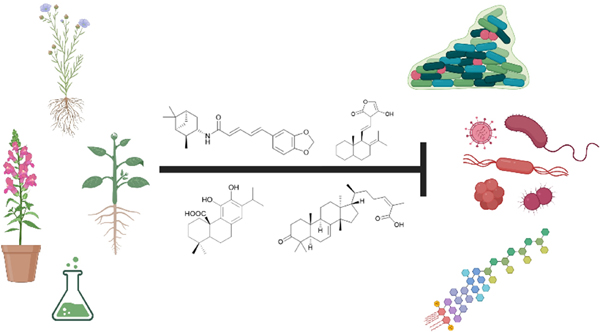
Plants produce a wide array of secondary metabolites capable of inhibiting pathways crucial for microbial survival and pathogenicity.
1. Introduction
Antimicrobial resistance (AMR) poses a significant public health threat in the modern era. As antibiotics lose their effectiveness due to the development of drug resistance, the treatment of recalcitrant infections becomes increasingly challenging, and in some cases, impossible. Researchers from the Centers for Disease Control and Prevention (CDC), World Health Organization (WHO), and public health institutions around the world continue to assert that remedial actions must be implemented globally to address the spread of AMR.1–3 According to the CDC, more than two million AMR infections occur annually in the United States, resulting in an estimated 29,000 deaths; the medical cost for AMR treatment is over $4.7 billion.2 Although the degree of AMR varies greatly depending on the bacterial species and geographic region, AMR is prevalent across the globe. For example, in the European Union/European Economic Area (EU/EEA) alone, it is estimated that more than 670,000 infections are caused by AMR each year and about 33,000 deaths as a result of it.4 An assessment of 2019 global data found that an estimated 4.95 million deaths were associated with bacterial AMR, including 1.27 million deaths attributed to bacterial AMR.5 During the global COVID-19 pandemic, AMR rates have continued to rise. In the period from March to October 2020, nearly 80% of hospitalized patients for COVID-19 received antibiotics, which contributed to this AMR trend.6
In February 2017, the WHO published a list of pathogens in urgent need of new antibiotics and provided guidelines to focus researchers’ research and development efforts on high-priority targets. Six pathogens, in particular, were issued with priority ratings and named the ESKAPE pathogens (Enterococcus faecium, Staphylococcus aureus, Klebsiella pneumoniae, Acinetobacter baumannii, Pseudomonas aeruginosa, and Enterobacter spp.).7, 8 To overcome the challenges of AMR, the development of rapid point-of-care diagnostic methods, discovery of new drug candidates, and rapid development of existing candidates are all necessary.
About half of the drugs registered by the FDA between 1981 and 2019 were natural products, mimetics, or derivatives, which was roughly double the share of all synthetic drugs (24.6%).9 Among these drugs, natural products continue to be an important source for the discovery and development of anti-infective drug candidates. Around 42.3% of all anti-infective agents are derived from natural products, their derivatives, and natural product mimics.9 Natural products are characterized by a great diversity of scaffolds and high structural complexity. Among plant-derived natural products, alkaloids, phenolic derivatives, and terpenoids are promising sources of antibacterial lead compounds that can help fill the drug development pipeline. In addition to their potential value as classic antibiotics targeting growth and survival, some plant-derived natural products also show promise as synergists, targeting bacterial virulence and pathogenesis pathways, or by sensitizing bacteria to established classes of antibiotics.10–12
Bacterial resistance to antimicrobials is enabled through a few core mechanisms, including inactivation or alteration of antibacterial molecules, modification of bacterial target sites, reduction of antibiotic penetration/accumulation, and formation of bacterial biofilms.13 Plant natural products can act as antibacterial agents through a variety of modes of action targeting these resistance mechanisms and other pathways necessary for bacterial survival. In this paper, we review recent findings from the last five years (Jan 2018 – Sep 2022) on plant natural products that exhibit anti-infective properties against pathogenic bacteria, including growth inhibition, antivirulence, and antibiofilm activity. We also introduce traditional knowledge of medicinal plants used for the treatment of infectious diseases in the study of source material for plant natural product discovery in the context of ethnobotany—the study of local plant and their practical uses through accumulated knowledge of local culture and people.14 We present a summary of activities for plant-derived natural products exhibiting promising activity as antibiotic, antivirulence, and antibiofilm leads in Tables 1–3. This review will be of critical importance to the natural product community, filling a gap in comprehensive reviews on plant-derived natural products for the treatment of infection.
2. Methods for Review
Our previous comprehensive review of plant derived natural products with antibacterial activity examined the literature from January 1st, 2012 to September 3rd, 2019.10 This review seeks to build on that by examining the literature for plant-derived and plant-inspired antimicrobial compounds that met our rigorous inclusion criteria from articles published from January 1st, 2018 to September 30th, 2022. This review specifically focuses on recently reported natural products with antibacterial, antivirulence, or antibioflm activity.
Articles were searched on PubMed with specific key words for each type of activity. Antibacterial key terms searched were “(antibiotics) AND (natural product)” and “(antibiotics) AND (isolated) AND (natural product)”, “(natural product) AND (antibiotic) AND (novel)”, “(antibiotic) AND (natural product)”, “(plant) AND (antibiotic) AND (novel compound)”, and “(antibiotics) AND (extract)” and “(antivirulence) AND (plant)” on PubMed and Google Scholar; Reaxys key terms were “antibiotic, natural product >=2018” and “Pharmacological data, article, antibiotic”. Antivirulence key terms searched were “(virulence) AND (natural product)” on PubMed and Google Scholar; Reaxys key terms were “antivirulence, natural product >=2018” and “Pharmacological data, article, antivirulence”. Antibiofilm key terms searched were “(biofilm) AND (natural product)” and “(biofilm) AND (plant)” on PubMed and Google Scholar; Reaxys key terms were “biofilm, natural product >=2018” and “Pharmacological data, article, biofilm”. As lead hits were selected, similar searches were performed including the compound name and “derivative”.
The initial search yielded thousands of results, prompting us to establish criteria to refine our selection. First, we selected papers to only include terrestrial plant derived natural products with activity specifically against multidrug resistant bacteria. Next, we filtered our results to only include single compounds rather than essential oils or extracts. Additionally, we searched for novel products and allowed for derivatives from well-studied parent compounds (such as myricetin and quercetin), while excluding results that utilized nanoparticle technology. For antibiofilm results, we cross checked with the 2020 Natural Product Reports review “Natural products as inspiration for the development of bacterial antibiofilm agents” by R.J. Melander et al. to prevent redundant reporting in the literature.15
An additional round of literature review on PubMed and Google Scholar was developed after identifying our lead compounds. Our first round was centered on reports of each compound’s mechanism of action in bacteria, then we transitioned to review their bioactivity against other diseases. Finally, we searched records for ethnobotanical information for each plant. The resources for ethnobotanical information included review articles, textbook chapters, and primary field reports as available.
2.1. Data Reporting
2.1.1. Antibacterial
Antibacterial compounds either kill the bacterial cells (bactericidal) or interfere with growth (bacteriostatic). Antibacterial compounds have multiple mechanisms of action broken down into four general classes: cell wall synthesis inhibitors, protein synthesis inhibitors, nucleic acid synthesis inhibitors, and compounds that alter cell membrane function.16 To compare efficacy between antibacterial compounds, we used the minimum inhibitory concentration (MIC), a standard indicator for the antibacterial potency of a compound. MIC is the lowest concentration of drug that inhibits the visual growth of a microbe in vitro. The most common experimental techniques to determine the MIC comprises microtiter dilutions against bacteria in liquid broth, and time-kill assays (which also may inform the mechanism of action).17 In this review, we highlight some of the latest plant derived and plant inspired natural products that displayed strong (MICs ≤ 20 µg/mL) antibacterial activity.
2.1.2. Antivirulence
Disrupting virulence for the treatment of bacterial infections is an alternative approach for addressing the antibiotic resistance crisis.18 Bacteria display many different mechanisms of virulence. Virulence is the degree to which the bacteria can infect or damage a host, with virulence factors being defined as products that the bacteria produce to affect this pathogenicity.19 Ideally, an antivirulent compound mitigates bacterial virulence or reduces virulence factors while not disrupting growth, thus potentially reducing the rate of resistance acquisition. Potential targets include surface proteins, which may provide more accessible targets than traditional cell-penetrating antibiotics. Virulence factors are broad and can include toxins, secretion systems, adhesin, and siderophores.18 Some common mechanisms for testing antivirulence include the measurement in reduction of these secreted virulence factors, inhibition of key biosynthetic enzymes, gene reported assays to assess the downregulation of virulence pathways, or reduction in host cell damage upon treatment with pathogenic bacteria. The compounds reviewed in this section are plant-derived secondary metabolites recently reported for antivirulence activity in bacterial pathogens.
2.1.3. Antibiofilm
Biofilms are virulence factors that contribute both to pathogenicity and antibiotic resistance through conferring intrinsic resistance to many antibiotic therapies. Biofilms are composed of extracellular polymeric substances (EPS) that form a matrix enclosing bacterial cells, leaving bacteria cells impenetrable to many therapeutics.20 Disrupting biofilm is a key target in drug discovery as it can increase the effectiveness of antibiotics and antivirulence drugs. The studies discussed here include promising plant-derived natural products as biofilm inhibitors. Biofilm formation occurs first with attachment (reversible and irreversible), then growth, maturation, and dispersal.21 The majority of studies discussed herein focus on the inhibition of biofilm growth or damage to mature biofilms. The output of these studies measures the minimum biofilm inhibitory concentration (MBIC) during the initial stages or minimum biofilm eradication concentration (MBEC) when evaluated against a mature biofilm. Staining with crystal violet is a standard method to observe biofilm coverage of well plates in the presence and absence of test compound.22 Confocal scanning laser microscopy and scanning electron microscopy are examples of methods used to measure biofilm thickness and morphology,23 The previous methods are primarily static measures of biofilm behavior, while rotary biofilm reactors and biofilm microfluidic devices are used to replicate biofilm formation in a physiologically relevant setting.23
2.2. Chemical Structures
Chemical structures reported in this review are based upon the published structure within each manuscript if available and PubChem for those not reported. Structural figures were produced using ChemDraw 21.0.0 by PerkinElmer Informatics.
2.3. Plant Nomenclature
Plant nomenclature is updated periodically, and it is important to differentiate the accepted plant names from common names. The full accepted name of each plant in this review was to include genus, species, author epithet, and family. Each plant mentioned in the literature was verified on World Flora Online (http://www.worldfloraonline.org) to ensure that the nomenclature is current and up to date.
3. Plant-Derived Natural Products with Antimicrobial Activity
3.1. Alkaloids
Alkaloids have been used in botanical medicine for over >3500 years, with the Ebers papyrus (~1500 BCE) mentioning the first recorded medical use of the opium poppy.24 They are a diverse class of natural products originally documented as basic, organic nitrogen-containing secondary metabolites produced by plants, microbes, and animals. The class is broadened to now include most nitrogen-containing natural products of low molecular weight or their derivatives.25 The most prevalent class are indole alkaloids, with other classes including, tropane, quinoline, isoquinoline, pyridine, pyrrolidine, pyrrolizidine, and steroidal alkaloids. Many plant alkaloids and their derivatives are still prescribed today for a variety of medical reasons such as severe pain (oxycodone, morphine, fentanyl), as antimalarials (quinine), to treat hypotension (ephedrine), or used recreationally (caffeine, nicotine, cocaine). Medicinal chemists often explore the inclusion of nitrogen into the parent compound due to its remarkable ability to improve the pharmacological profile of new drug derivatives.26 Several plant natural product alkaloids, or their derivatives, with antibacterial activity are described below.
3.1.1. Amide alkaloids
Piperine (1) and piperlongumine (2) are amide alkaloids found in many species of Piper. Piper betle L. in the Piperaceae family has been used extensively in Ayurvedic medicine in many applications with some examples being as an antihelminthic, astringent, and to treat diarrhea.27 Several different species of Piper are used throughout Peru, Brazil, Panama, and Mexico for treating a variety of ailments such as toothaches, dysentery, coughs, wound healing, and more.28 In addition to these traditional uses, piperine has multiple biological uses and has been found to have anti-tumor, antifungal, analgesic, and anti-depressant properties.29
Mgbeahuruike et al. found 1 and 2 to have antibacterial activity against Staphylococcus aureus and Pseudomonas aeruginosa.30 Philipova et al. synthesized a series of piperine derivatives with different cyclic amines.31 These piperine derivatives 1a – 1e were found to have potent anti-bacterial activity against Mycobacterium tuberculosis with MICs between 0.15 – 0.36 µM. 1e was the most promising compound with an MIC of 0.18 µM and cytotoxicity IC50 of 249.8 µM (vs HEK293) and a selectivity index of >1300. The authors also conducted quantitative structure-activity relationship studies and found that quaternary carbons were necessary for anti-tuberculosis activity.
While the mechanism of action (MOA) for these compounds has not been identified, it has been theorized that piperine’s antibacterial activity occurs through an increase in mTORC1 signaling. A study reported that mTORC signaling led to an increase in the bacterial phagocytic ability of peritoneal macrophages in mice and the subsequent increase in bacterial clearance.32
3.2. Phenolics
The oldest historical record of plant phenolic compounds used as medicine comes from the Ebers Papyrus (~1500 BCE), where ancient Sumerians and Egyptians recorded the uses of what is now known as willow for treating pain and fever.33 Thousands of years later, salicin and salicylic acid were isolated and later derivatized to acetylsalicylic acid. Better known by its generic name, Aspirin, it has since become the most used drug in the world,33 providing one of the ultimate examples of ethnobotanical records guiding the discovery of a new drug. There are over 8,000 known plant phenolic compounds34, making it the largest class of plant secondary metabolites.35 They are seemingly ubiquitously expressed in plants and play many roles, from defense and signaling to pigment biosynthesis and regulation growth.35 Phenolics are classified as having at least one hydroxyl group directly bonded to a mono or polycyclic aromatic hydrocarbon and are biosynthesized through shikimate or phenylpropanoid pathway36. The phenolic compounds highlighted below are those that exhibit antibacterial properties.
3.2.1. Lignans
Ligustchuanes A and B (3, 4) are two novel epimeric lignan trimers containing a unique neolignan linkage, ferulic acid, and ethoxyl groups isolated from the rhizomes of Ligusticum striatum DC., Apiaceae, each in a racemic mixture.37 Lignans are a structurally diverse group of phenols characterized by β,β′ linkages of phenyl propane units. Diversity stems from varying degrees of side-chain oxidation, diversity of the aromatic ring, or changes in the linkage of the two or more units.38 Compounds 3 and 4 (tested in respective racemic mixtures) disrupt the virulence of Staphylococcus aureus through the disruption of α-Hemolysin. This toxin facilitates the penetration of host cells by forming pores on the membrane.39 Molecular docking studies show that both enantiomers of ligustchuane B can bind to α-Hemolysin heptamer, indicating a possible mechanism of action. Despite the structural similarity between ligustchuanes A and B, ligustchuane B exhibits a 32-fold increase in activity, emphasizing the importance of the chiral centers of the molecule. L. striatum (common name chuanxiong) has been used in Traditional Chinese Medicine (TCM) for thousands of years, first recorded in Shennong’s Classic of Materia Medica,40 a text containing 365 medicinal compiled during the end of the Eastern Han Dynasty (25–220 AD).41 The rhizomes of L. striatum have been traditionally used to treat gynecological diseases, irregular menstruation, amenorrhea, dysmenorrhea, headache, rheumatism arthralgia and hemiplegia caused by stroke, coronary heart disease, and possess anti-inflammatory properties.37, 40, 42 Most medicinal preparations with chuanxiong are combined with other plants, commonly Angelica sinensis (Oliv.) Diels (Apiaceae), Paeonia lactiflora Pall. (Paeoniaceae), and Borneolum syntheticum (a processed product produced from a combination of turpentine and camphor),40 however, it is also used in treatment as a stand-alone ingredient.
Phillygenin is a phillyrin aglycone lignan.43 Li et al. reported phillygenin (5) isolated from Forsythia suspensa Vahl, Oleaceae, to prevent biofilm formation at 100–150 μg/mL in Helicobacter pylori. Additional studies on 5 show it can act as an antioxidant, protect high density lipoprotein and low density lipoprotein lipid peroxidation, and may also have anti-inflammatory activity.44–46 The fruit from Forsythia suspensa has a rich history in Chinese traditional medicine, with uses including the treatment of gonorrhea, inflammation, cough, ulcers, and parasites.47
3.2.2. Anthraquinones
Quinones are composed of aromatic rings with two ketone substitutions in the structure,10 and this chemical class can be divided into subcategories of benzoquinone, naphthoquinone and anthraquinone. Among them, anthraquinones are found throughout nature and have been isolated from fungi, plants, and bacteria. Anthraquinones contain an anthracene skeleton with keto groups on the 9′ and 10′ position of the tricyclic ring. They display a wide range of bioactivities such as anticancer, anti-arthritic, and laxative properties.48 Compound 6 is an anthraquinone derivative that was isolated from the stem bark of Stereospermum fimbriatum DC., Bignoniaceae; 6 displayed potent activity against MRSA with an MIC of 6.25 µg/mL.49 S. fimbriatum has been traditionally used in Malaysia to treat earaches, itchy skin, and dermatosis.50 The antibacterial mechanism of action for 6 is unknown, but it has been noted for other anthraquinones against gram-positive bacteria, that as carbon number increases so does the antibacterial activity.51 This trend suggests that lipophilicity and the ability to permeate/disrupt the bacterial membrane is one major factor in the antibacterial activity of anthraquinones against gram-positive bacteria.
Rhein (7), rhein-8-O-β-d-glucopyranoside (8), emodin (9), N’-((4,5-dihydroxy-9,10-dioxo-9,10-dihydroanthracen-2-yl)methylene) benzenesulfonohydrazide (an aloe emodin-conjugated sulfonyl hydrazone) (10), chrysophanol (11), and hypericin (12) are all examples of this diverse and rich class of biofilm inhibitors.
Anti-biofilm activity of anthraquinone rhein (7), which can be isolated from traditional medicinal plants Rheum palmatum L. (Polygonaceae), Senna tora (L.) Roxb. (Fabaceae), Reynoutria multiflora (Thunb.) Moldenke (Polygonaceae), and Aloe vera (L.) Burm.f. (Asphodelaceae), was discovered by Folliero et al.52 This study identified 7 to eradicate biofilm formation against Streptococcus mutans with an MBEC50 of 6.31 µg/mL and MBEC90 > 50 µg/mL. At 6.25 µg/mL, inhibition of biofilm formation and decreased thickness of the biofilm was observed. In addition to its antibiofilm activity, studies have shown that rhein also demonstrates growth inhibition of various bacteria strains.53–55 Rhein is also neuro and hepatoprotective, as well as anti-cancer and anti-inflammatory.56
A related compound, (8) was also reported to have anti-biofilm properties.57 Zhang et al. studied 8, which is isolated from the roots of Aucklandia costus Falc. (Asteraceae) and the roots of Rheum palmatum. A dose-dependent effect of 8 was seen against S. mutans, with 60% inhibition of biofilm formation at 10 µg/mL of 8 and complete inhibition at 50 ug/mL. Zhang et al. also observed a decrease in the expression of the genes brpA and luxS, which engage in biofilm and may be one MOA through which 8 inhibits biofilm formation. Studies have reported that 8 inhibited the activity of PTP1B, prevents apoptosis, and promotes the purgative activity of sennoside A.58–60
Rhein and 8 are isolated primarily from Rheum palmatum, which has a rich history in traditional Chinese medicine.61 Traditional use includes it in preparations to treat fever, and eliminate blood stasis, burns, and cancer.61
Đukanović et al. demonstrated the antibiofilm of emodin (9) isolated from Frangula alnus Mill. (Rhamnaceae) bark activity against methicillin-resistant and methicillin-sensitive Staphylococcus aureus strains.62 Significant biofilm formation inhibition was observed in both strains at concentrations as low as 0.05 µg/mL with the highest concentration tested at 3.125 µg/mL. Emodin was also evaluated on mature biofilms to determine its potential to eradicate biofilm. Methicillin-resistant strains demonstrated 30% biofilm eradication at a concentration of 12.5 µg/mL. Additionally, this study found some strains displayed a decrease in ica genes, which polysaccharide intercellular adhesin is dependent upon and plays a key role in biofilm formation.63 Emodin also demonstrates antioxidant, anti-inflammatory, antiviral, anti-diabetic, and anticancer.64 F. alnus has traditional medicinal use in Europe with the bark used as a laxative or to induce vomiting.65
A similar compound derived from aloe emodin, aloe emodin-conjugated sulfonyl hydrazone 5a (10), reportedly demonstrates anti-biofilm properties as well.66 Aloe emodin is a key component in much of Chinese traditional medicine and can be derived from Rheum palmatum and Senna obtusifolia (L.) H.S.Irwin & Barneby (cassia seed). Significant biofilm reduction (40%) by this compound was observed at 4 µg/mL in methicillin-resistant S. aureus. In addition to biofilm inhibition, the compound also demonstrated dispersion of the biofilm into the planktonic culture which led to decreased resistance. The method of action in which this specific emodin derivative acts as a biofilm inhibitor remains to be explored.
Another phenolic compound found within Rheum palmatum that also demonstrates antibiofilm activity is chrysophanol (11).67 This study reports inhibition of biofilm formation (around 60%) in Staphylococcus suis at concentrations as low as 0.112 µg/mL. SEM results demonstrated a single molecule state of the bacteria cells with a lack of interconnection to create a biofilm, however, the exact mechanism of antibiofilm action needs to be further explored. Studies report chrysophanol also has uses in treating cardiovascular disease, treating cancer, providing neuroprotection, and preventing inflammation.68
Hypericin (12) derived from Hypericum perforatum L. (Hypericaceae) was reported by Wang et al. to inhibit biofilm formation (~ 60%) in S. aureus at 8 µg/mL.69 This study reports that hypericin decreases gene expression of sarA, a key gene for biofilm formation, but still requires further mechanism of action studies. Additional studies report hypericin has anticancer activity and antiviral activity.70, 71 Hypericum perforatum has a history dating back the ancient Greek physicians for wound healing, promoting diuresis, and eliminating parasites.72 As its use spread throughout Europe in the 1500s, it was also used to treat anxiety and depression.72
3.2.3. Coumarins
Umbelliferone (13), a common secondary metabolite primarily isolated from plants from the Apiaceae family, was recently reported by Swetha et al. to inhibit biofilm formation (~50%) in Staphylococcus epidermidis at 200 µg/mL.73 Umbelliferone is a coumarin, a class of compounds composed of a α-pyrone ring that is fused to a benzene.10 This study also demonstrates inhibition of biofilm adherence at 500 µg/mL. Additionally, genetic studies revealed the downregulation of key genes for biofilm formation via adhesion (icaD, aap, and bph). Amin et al. studied compounds having a moiety of umbelliferone isolated from Ferula narthex Boiss., Apiaceae exudate against S. epidermidis and found faselol (14), to have a minimum biofilm inhibitory concentration (MBIC) of 174 µg/mL and 87 µg/mL against S. aureus.74 These results suggest further modification of umbelliferone may lead to discovery of a more potent antibiofilm compound. In addition to its antibiofilm properties, 13 also demonstrates anti-fungal, antioxidant, and antidiabetic activities.75 The Apiaceae family contains many traditional medicinal plants, and some examples of plants with ethnobotanical uses in Iran include Cuminum cyminum L. (cumin), Ferula gummosa Boiss. (galbanum), Foeniculum vulgare Mill. (fennel), Anethum graveolens L. (dill) and Pimpinella anisum L. (anise).76 Ferula narthex has historical use in medicine throughout many countries such as Afghanistan, Morocco, Egypt, Nepal, and India.77 Specifically in India its uses include treating kidney stones, aiding in digestion, preventing spasmodic disorders, and treating bronchitis.77
3.2.4. Flavonoids
Flavonoids consist of a general skeleton of 15 carbons in a C6–C3–C6 motif arranged as two benzene/phenyl rings and a pyran ring.78 Isoflavonoids are distinguished by the phenyl group on the C3 position of the center ring and flavones have this phenyl group on the C2 position. Biochanin A (15) is an isoflavonoid—a phytochemical class often referred to as phytoestrogens—found chiefly in members of the Fabaceae (legume) family. Biochanin A has also been reported to display antidiabetic and anticancer activity.79, 80 Acacetin (16) is a flavone that is derived from apigenin and has been found to inhibit monoamine oxidase A/B.81 Pachaiappan et al. found 15 and 16 to have activity against P. aeruginosa with MICs of 0.97 and 3.90 µg/mL, respectively.82
Myrsininone A (17) and 18 are also both isoflavones, isolated from the fruits of Ficus auriculata Lour. from the Moraceae family. Myrsininone A has been reported to have anti-diabetic activity and has been found to inhibit α-glucosidase.83 Both 17 and 18 displayed potent activity against various bacterial strains with MICs between 1.25 – 10 µM and 10 – 20 µM, respectively.84 F. auriculata is native to Asia and the Himalayan regions. Leaves of this plant have been used as a paste for the treatment of wounds and the fruits have been used for hepatic and neurodegenerative diseases.85
While the mechanism of action for the antibacterial activity of many flavonoids remains unknown and many targets and MOAs have been proposed, it has been postulated that they may act through nonspecific action upon the bacterial cell membrane. Flavonoids have been found to permeate the cell membrane,86 disrupt cellular membrane integrity,87 and a relationship has been shown between their lipophilicity and antibacterial activity.88
3.2.5. Tannins
Corilagin (19) is a hydrolysable tannin, a compound class containing a central glucose or polyol moiety, esterified by gallic or ellagic acids. Corilagin is considered an ellagitannin and comprises of a hexahydroxydiphenoyl group that bridges the glucose core which was first isolated by Schmidt et al. in 1951 from Libidibia coriaria (Jacq.) Schltdl., Fabaceae,89 a plant used in traditional Mexican medicine.90 19 was found to inhibit the hemolysis ability of S. aureus at a concentration range of 6 – 10 µg/mL in addition to reducing the expression of accessory gene regulator A at 6 µg/mL, thus disrupting quorum sensing. 19 is also found in multiple species of the genus Phyllanthus91, of which many have use in Ayurvedic medicine.92 In addition, 19 has displayed anti-tumor, anti-oxidant, anti-inflammatory properties.91
3.2.6. Xanthones
Xanthones, such as α-mangostin, are a class of compounds that possess a 9H-xanthen-9-one scaffold.93 Felix et al. reported α-mangostin (20) isolated from the fruit of Garcinia mangostana L., Clusiaceae, to inhibit biofilm attachment and biofilm formation in S. aureus94. α-Mangostin demonstrated 75% inhibition of attachment at 4 µg/mL and the reported MBIC is 2 µg/mL. At 4 µg/mL this compound also eradicated 96% of established biofilms. Confocal microscopy revealed this compound alters the thickness of the biofilm during formation and after a mature biofilm has formed. Lastly, this study reports in the presence of α-mangostin a decrease in gene expression of dnaK which plays a role in biofilm formation, suggesting this may play a part in the mechanism of action.95 Additional studies show α-mangostin has a wide variety of additional activities such as anti-inflammatory, neuroprotective, and anti-viral.96–98 G. mangostana fruits have historically been used to treat skin infections in southeastern Asian medicine.99 Ayurvedic medicine primarily used this fruit to treat inflammation, digestive illnesses, and cholera.99
3.2.7. Diarylheptanoids
Curcumin (diferuloylmethane) (21) is a linear diarylheptanoid in its own group called curcuminoids. Curcuminoids are a class of compounds exhibiting two aromatic rings bridged by a linear seven-carbon chain, of which curcumin’s chain exhibits an α,β-unsaturated β-diketone moiety.100 Under more alkaline conditions and in solid forms the keto-enol tautomer is favored.100, 101 The derivatives (22, 23) synthesized contain modifications to the methoxy and hydroxy moieties of the phenyl units. Antivirulence activity examined the ability of compounds 21, 22, and 23 to inhibit Streptococcus pneumoniae and Vibrio cholerae sialidase enzymatic activity with a focus on S. pneumoniae NanA sialidase, a key component in bacterial interaction with host cells.102 Compounds 22 and 23 showed an approximate three-fold increase in activity on S. pneumoniae NanA sialidase and V. cholerae sialidase respectively, compared to curcumin (21). Compound 22, a novel structure, was a competitive inhibitor whereas all others synthesized were non-competitive inhibitors. Curcumin was first isolated from the rhizomes of Curcuma longa L., Zingerberaceae (turmeric) by Vogel and Pelletier103 in 1842.
Turmeric has been used in Vedic culture for around 4000 years as a culinary spice, for cosmetics, and as medicine104. Ayurvedic medicinal practices use turmeric to treat respiratory conditions, anorexia, rheumatism, runny nose, cough, sprains, and swelling.104, 105 It has also been used to as an antibacterial agent for the treatment of burns and cuts in many South Asian countries.104
3.2.8. Stilbenes
Salvianolic acid A (24) was first isolated from the dried roots of Salvia miltiorrhiza Bunge, Lamiaceae in 1984106 and is classified as a stilbenoid. Although there are various sub-categorizations, stilbenoids have a basic C6–C2–C6 unit in their structure. 24 was reported to have activity against SrtA in Methicillin-resistant Staphylococcus aureus (MRSA), a surface protein transpeptidase responsible for bacterial adherence to host cells.107 Free protein binding assays with SrtA determined a reversible inhibition with an IC50 of 5.75 µg/mL, with further binding studies concluding a Kd of 21.53 nM and prediction of the binding pocket using molecular docking studies.107 In vivo studies in a lethal MRSA-induced pneumonia mouse model of infection showed a 100% survival rate when used in the combination of current antibiotic latamoxef.107 S. miltiorrhiza roots have been used in TCM for more than 2000 years and are recorded in Shennong’s herbal classic of Materia Medica.108 Traditional use includes using the dried roots in the form of decoctions or pills either alone or in combination with other herbs to treat coronary heart disease and cerebrovascular diseases.109
Hopeaphenol, isohopephenol, and ampelopsin A (25, 26, and 27) are oligomeric stillbenoids isolated from the roots of Vitis vinifera L., Vitaceae. Their biosynthesis is derived from the oligomerization of resveratrol, of which dimers through octamers have been found.110, 111 Besides V. vinifera, resveratrol oligomers have been isolated from various other Vitis species and plant families such as Cyperaceae, Dipterocarpaceae, Fabiaceae, Gnetaceae, and Paeoniaceae.112–114 Resveratrol oligomers have been found to interfere with the type III secretion system (T3SS) of various human and plant pathogens.115, 116 The T3SS system is a needle-like structure in gram negative bacteria that allows the bacteria to penetrate host cell membranes and transfer various substrates.18 In Pseudomonas syringae pv. Tomato DC3000, these oligomers exhibit antivirulence through the decreased expression of various hrp gene clusters of the T3SS including hrpA, hrpL, and hop1,116 while resveratrol itself had no effect. Resveratrol can be produced at increasing amounts at sites of plant infection, allowing also for the biosynthesis of oligomers with more potent activity.110 Various resveratrol oligomers have been shown to have antibacterial, antioxidant, anti-neurodegenerative, anti-tumor, as well as heart and liver protective effects.111 Many plant foods and medicines contain resveratrol117 and various oligomers, with TCM preparations displaying numerous decoctions and granules in which resveratrol has been found.118 These traditional preparations focus on treating lung diseases such as pneumonia, chronic obstructive pulmonary disease, asthma, and idiopathic pulmonary fibrosis and asthma.
3.2.9. Methoxybenzenes
Paeonol (28) is a member of the methoxybenzenes and alkyl-phenyl ketones. It has an acetophenone core with a 2-hydroxy,4-methoxy substituted ring. It is isolated from the root bark of Paeonia suffruticosa Andrews, Paeoniaceae,119 but can also be found in other species120 and even different plant families.121 28 was examined for its ability to affect Salmonella enterica serovar Typhimurium type III secretion system (T3SS), a multicomponent molecular system that facilitates invasion, intracellular replication, and affect host inflammation encoded by the Salmonella pathogenicity island (SPI).122 28 significantly reduced host cell injury and reduced cellular invasion by S. typhimurium at a concentration of 95 µM as well as increased the survival rate in a S. typhimurium infection model with no observed cytotoxicity. From this study, it is proposed that 28 inhibits the expression of key effector proteins of T3SS through the reduction of the transcription level of hilA in the SPI-1 regulatory pathway.122 P. suffruticosa commonly referred to as tree peony, has been used in TCM for thousands of years, traditionally prepared by creating slices the root cortex, referred to as “Danpi”.123 Danpi has been used in the form of decoctions, granules, and pills to treat blood stasis through promotion of blood circulation. It is also used to treat amenorrhea and dysmenorrhea, skin sores and bruises.123
3.3. Terpenoids
Terpenoids, a class of organic compounds comprised of an isoprene unit, have been used in medicine for thousands of years. Roughly 2000 years ago, the use of Artemisia annua L. for fever reduction was recorded in a text called “52 Prescriptions”, recovered from the Mawangdui Han dynasty tomb.124 More than a thousand years later, the active compound Artemisinin (a sesquiterpene lactone) was discovered and in 2015, Tu Youyou was awarded the Nobel Prize for her contributions. Terpenoids play broad roles in plant growth and development and plant odors. Another example of is that of paclitaxel, a tetracyclic diterpenoid isolated from the Pacific Yew tree used successfully in the clinic as a chemotherapeutic. Outlined below are terpenoids found within the search criteria as possessing various antibacterial properties.
3.3.1. Diterpenoids
Carnosic acid (29) is an abietane diterpenoid found in the aerial parts of Lepechinia meyenii (Walp.) Epling, Lamiaceae.125 Carnosic acid is also found in other members of the Lamiaceae family such as rosemary (Rosmarinus officinalis L.) and has been reported to have antioxidant and anti-adipogenic properties.126 Abietane diterpenoids are characterized by a tricyclic C20 skeleton with an aromatic C ring.127 The MOA for growth inhibition by carnosic acid is currently unknown but it has been shown that abietane diterpenes interact with the phospholipid bilayer of membranes.128, 129 L. meyenii has historically been used in Peru for a variety of ailments such as bronchitis, heart issues, and wound healing and hair loss.130 A decoction of the whole plant is typically consumed as a beverage or used in combination with other plant species for bathing.130 Chabán et al. found that carnosic acid displayed antibacterial activity against Enterococcus faecalis and methicillin-resistant Staphylococcus aureus (MRSA) with MICs of 15.6 and 7.8–15.6 µg/mL, respectively.125 Derivatives of carnosic acid were also made by the authors and yielded 30 and 31. The lactone derivative 30 was found to have reduced activity compared to the parent (29) but 31, the C20 methylated derivative, was found to have a greater increase in antibacterial activity than the parent compound. Additionally, this same study found that the hydroxyl group on the C12 of carnosic acid and its derivatives was required for antibiotic activity.
Compound 32 is a diterpene lactone andrographolide isolated from Helichrysum caespititium (DC.) Sond., Asteraceae, with antibiofilm properties against Neisseria gonorrhoeae 131. When tested at 60 µg/mL, 32 inhibited biofilm cell attachment by 81%, but only inhibited biofilm formation by 32%. The potential mechanism of action may be a disruption of the EPS cohesiveness. H. caespititium has many known uses in traditional medicine across South and Central Africa, individually against respiratory infections, and as a component of traditional medicinal mixtures for various other diseases.132
Andrographolide sulfonate (33) isolated from Andrographis paniculata (Burm.f.) Wall., Acanthaceae, demonstrates antibiofilm activity against MRSA at a test concentration of 25 mg/mL.133 This concentration is considered very high, but the minimum inhibitory concentration of bacterial growth for this compound is 50 µg/mL. This highlights the potential for derivatives to work as antibiofilm inhibitors. Additionally, this study observed downregulation of genes associated with intracellular adhesion (icaA, icaD, and PIA), key to biofilm formation, in the presence of the compound. Andrographolide sulfonates are part of injections based on TCM and are currently approved in China to treat respiratory infections, tonsillitis, and numerous other infections.134 A. paniculata has uses in traditional Chinese medicine to treat snake bites, sore throats, and to treat colds and fevers.135
3.3.2. Triterpenoids
Triterpenes are a common natural product found throughout nature that shares the common structural formula C30H48. There are over 20,000 natural triterpenes known.136 An annual review by Connolly and Hill catalogues the latest triterpenes isolated from nature.137 Pentacyclic triterpenes are a class of triterpenes characterized by their 5-membered rings and include the compounds ursane, lupane, and oleanane.138
Starting with various pentacyclic triterpene skeletons, Kazakova et al. (2021) synthesized multiple pentacyclic triterpenoid derivatives (34–38) and studied their efficacy against the ESKAPE pathogens.139 These derivatives were found to have MICs of 0.15 µM against S. aureus. The MOA for growth inhibition by these pentacyclic triterpenoid derivatives is currently unknown. But, pentacyclic triterpenes have been reported to disrupt the bacterial cell membrane and inhibit NADH oxidation in S. aureus.140
In a separate study by Kazakova et al. (2021), the authors tested the antibacterial activity of different oleanolic acid derivatives.141 39 is a derivative of oleanolic acid, a compound found in over 1,600 plant species and found in many members of the Oleaceae family.142 39 was found to have anti-MRSA activity and also displayed anti-chlamydial activity. The MOA for 39 was not reported, but a previous study has reported that oleanolic acid and related derivatives have been found to deregulate peptidoglycan metabolism in S. aureus.143
Betulin (40) and celastrol (41) are two triterpenoids also possessing antivirulence activity. Betulin is a pentacyclic triterpenoid of lupane structure and contains a hydroxy and hydroxymethyl group. It can be found in a wide variety of Betula species (Betulaceae family) and is commonly isolated form birch bark which can contain around 20–30% betulin by dry weight.144 Many pharmacopoeias around the world have traditional medicinal application of plants of Betula species.145 In North America, gray birch bark (Betula populifolia Marshall, Betulaceae) was used by the Maliseet and Mi′kmaq to treat infected wounds.146
Experiments using Listeria monocytogenes show that 40 was able to inhibit listeriolysin O (LLO) hemolysis likely by disrupting LLO oligomerization in concentrations as low as 4.5 µM. Additionally, bacterial burden in livers and kidneys of mice infected with L. monocytogenes was significantly reduced when administered at 50 mg/kg.147
Celestrol, also known as tripterine, (41) is a pentacyclic quinone methide triterpene and is present in high abundances in the roots of Tripterygium wilfordii Hook.f., Celastraceae.148 T. wilfordii has been used for more than two thousand years in TCM149 to treat various inflammatory disorders namely rheumatoid arthritis150 and has also been shown to possess anticancer properties.151 In S. aureus, celastrol inhibits a virulence factor called carotenoid staphyloxanthin (STX) which is essential for S. aureus to disrupt reactive oxygen species produced by host macrophages and neutrophils, thus reducing bacterial clearance by the innate immune system.152
Compounds 42, 43, 44 are triterpenoid acids, classified by having 30 carbons forming 6 isoprene units in their skeleton. Triterpenoids can be linear or cyclic, with 43 and 44 showing tetracyclic tirucallane-like structure and 42 with a pentacyclic oleanolic acid-like structure. Isolated from the fruits of Schinus terebinthifolia Raddi, Anacardiaceae, these compounds exhibit antivirulence in MRSA through quorum sensing inhibition of the accessory gene regulator (agr) system and broader antivirulence effects through targeting the sae-two component system.153 The agr signaling system has been found to be crucial for MRSA skin infection and leads to the production of toxins and exoenzymes.154 Compounds 43 and 44 exhibited the best activity with IC50 of the agr system ranging between 2–9 µM, decreasing δ-toxin, while exhibiting little to no growth inhibition at these concentrations. A traditional medicine in Brazil, its indigenous habitat,155 various parts of the plant have been used to treat wounds and ulcers of the skin, tumor, arthritis, infections of the urinary and respiratory tracts, and contusions.155, 156
Oleanolic (45) and maslinic acid (47) were isolated from the waste of olive oil, Olea europaea L., Oleaceae, and two promising C-28 amide derivatives were synthesized: oleanolic acid-HDA (46) and maslinic acid-HDA (48).157 These derivatives from oleanolic acid (45) and maslinic acid (47) demonstrated potential biofilm inhibition properties. At 50 µg/mL oleanolic acid (45) did not demonstrate notable destructive activity, but its derivatives 46, 47, and 48 were able to remove 99% of the pre-existing biofilm grown on catheters. 46 and 48 were also tested against a continuous biofilm after 4 days, and after 24 hours demonstrated a decrease in biofilm (30% for 46 and 45% for 48) and a decrease in the thickness (~10 µm). These derivatives potentially penetrate the bacterial cellular membranes causing damage, indicating a potential MOA. Oleanolic acid (45) is also reported to have anti-cancer anti-diabetic, hepatoprotective, anti-parasitic, anti-bacterial, and antioxidant activities.158 Maslinic acid (47) also has a range of additional activities including cardio protection, anticancer, antiparasitic, and anti-inflammatory.159 O. europaea can be found in medicinal practices throughout the globe including Japan, the United States, Brazil, and the Mediterranean as a laxative, anti-asthmatic, antibacterial, and anti-inflammatory.160
4. Summary Tables Organized by Activity
4.1.
Antibacterial
| Natural product compounds | Chemical Class | Plant source | Antibacterial activity |
Proposed Mechanism | Other biological activity | Refs. | ||
|---|---|---|---|---|---|---|---|---|
| Bacterial target | Activity (MIC) | Derivative activity (MIC) | ||||||
| Piperine (1) Piperlongumine (2) |
Amide Alkaloids | Piper species |
S. aureus
P. aeruginosa |
(1) 3.9–15.6 µg/mL (2) 3.9–31.2 µg/mL |
(1a–1e) 0.15–0.36 µM (M. tuberculosis) | – | Anti-tumor, antifungal. analgesic, and antidepressant Host targeted mechanism: Increased mTORC1 signaling leading to increased bacterial clearance by macrophages |
30
31 |
|
| ||||||||
| Biochanin A (15) | Flavonoids | Fabaceae species | P. aeruginosa | 0.97 µg/mL | – | – | Antidiabetic, anticancer | 82 |
|
| ||||||||
| Acacetin (16) | Flavonoids | Fabaceae species | P. aeruginosa | 3.90 µg/mL | – | – | MAO-A/B inhibitor | 82 |
|
| ||||||||
| Flavonoids (Isoflavonoids, flavones) Myrsininone A (17) (18) (6) |
Flavonoids (17, 18) Anthraquinone (6) |
Ficus auriculata (Lour.) (17) Ficus auriculata (Lour.) (18) Stereospermum fimbriatum (Wall. Ex G. Don) (6) |
various various MRSA |
1.25–10 µM (17) 10–20 µM 6.25 µg/mL |
- | Potentially through nonspecific action upon the bacterial cell membrane (17) Unknown (18–19) |
α-glucosidase inhibition IC50 50.5 ± 3.7 µM (17) |
84
49 |
|
| ||||||||
| Carnosic acid and derivatives Carnosic acid (29) |
Diterpenoids | Lepechinia meyenii (Walp.) |
E. faecalis, various MRSA strains |
15.6, 7.8–15.6 µg/mL | Anti-MRSA activity; (30), 31.2 µg/mL; (31) 3.9 µg/mL | Interaction with bacterial membrane phospholipids | Antioxidant and anti-adipogenic | 125 |
|
| ||||||||
| Triterpenic derivatives (34–38) |
Terpenoids | various | S. aureus | (34–38) 0.15 µM | – | Disrupts S. aureus cell membrane and inhibits NADH oxidation | – | 139 |
|
| ||||||||
| Oleanolic acid derivative (39) |
Terpenoids | various | S. aureus | 4 µg/mL (MRSA) | – | Deregulate peptidoglycan metabolism | Anti-chlamydial activity | 141 |
4.2.
Antivirulence
| Natural product | Compound Class | Plant source | Antibacterial activity |
Mechanism | Other biological activity | References | ||
|---|---|---|---|---|---|---|---|---|
| Bacterial target | Activity | Derivative activity | ||||||
| Curcumin (21) (22) (23) |
Diarylheptanoids | Streptococcus pneumoniae Nan A; V. cholerae | 0.6–5.3 µM (IC50) | 0.2–1.9 µM (IC50) | Sialidase inhibitors | – | 161 | |
|
| ||||||||
| Ligustchuanes (3) (4) |
Lignans | Ligusticum striatum DC. | Staphylococcus aureus | (4) 3 – 6 µM* (3)96 µM* |
– | Inhibits α-hemolysin secretion | – | 162 |
|
| ||||||||
| Paeonol (28) | Methoxybenzenes | Paeonia spp., dried root bark | Salmonella enterica serovar Typhimirium | 95–190 µM* | – | T3SS inhibitor, reduces SipA translocation and expression of effector proteins | – | 163 |
|
| ||||||||
| Salvianolic acid A (24) |
Phenolic derivatives | Salvia miltiorrhiza Bunge | Staphylococcus aureus | 5.75 µg/mL (IC50) | – | Inhibition of SrtA activity | – | 164 |
|
| ||||||||
| Resveratrol oligomers (25) (26) (27) |
Stilbenes | Vitis vinifera L. | Pseudamonas syringae pv. Tomato DC3000 | 25–100 µM* | – | Inhibition of T3SS through downregulation of hrp gene expression | – | 165 |
|
| ||||||||
| Corilagin (19) | Tannins | Terminalia chebula Retz | S. aureus | 6–10 µg/mL* | – | Quorum sensing inhibitor through agrA, Anti-α-hemolysin |
Biofilm inhibition, Pigment inhibition. Decreased STX production |
166 |
|
| ||||||||
| Betulin (40) | Terpenoids | Betula spp. | Listeria monocytogenes | 4.5 – 36 µM* | – | Inhibition of exotoxin, LLO activity | – | 147 |
|
| ||||||||
| Celastrol (41) | Terpenoids | Tripterygium spp. | S. aureus | 0.44–2.2 µM* | – | Decreased expression of virulence transcriptional regulators SigB, msaB, and stress adaptor yjbH | – | 167 |
|
| ||||||||
| Triterpenoid acids (42) (43) (44) |
Terpenoids | Schinus terebinthifolia Raddi | S. aureus | 2–70 µM (IC50) | – | Quorum sensing inhibitors | Biofilm inhibition | 168 |
Unspecified IC50, IC90, or activities of multiple assays listed as range
4.3.
Antibiofilm
| Natural Product Compounds | Natural Product Class | Plant source | Antibacterial activity | Mechanism | Other biological activity | References | ||
|---|---|---|---|---|---|---|---|---|
| Bacterial target | Activity | Derivative activity | ||||||
| Umbelliferone (13) Feselol (14) |
Coumarins | Apiaceae family (13) Ferula narthex Boiss. (14) |
S. epidermidis
S. aureus |
S. epidermidis 200 μg/mL MBIC (13) |
S. epidermidis 174 µg/mL MBIC S. aureus 87 µg/mL MBIC (14) |
Downregulation of genes key for biofilm formation via adhesion (icaD, aap, and pbh) | Anti-fungal, antioxidant, and antidiabetic activities | 73, 74 |
|
| ||||||||
| Phillygenin (5) |
Lignans | Forsythia suspensa Vahl | H. pylori | 100–150 μg/mL MBIC | – | – | Antioxidant, protection of HDL and LDL lipid peroxidation, and may also have anti-inflammatory activity | 43 |
|
| ||||||||
| Rhein (7) Rhein-8-O-β-D-glucopyranoside (8) |
Anthraquinones | Rheum palmatum L., Senna tora (L.) Roxb., Reynoutria multiflora (Thunb.) Moldenke and Aloe vera (L.) Burm.f. |
S. mutans
|
60% inhibition at 10 μg/mL, complete inhibition at 50 μg/mL (8) MBEC50 of 6.31 μg/mL and MBEC90 > 50 μg/mL (7) |
– | (7) may downregulate the expression of brpA and luxS in S. mutans |
Moderate bioactivity against human PTP1B (protein tyrosine phosphatase 1B) Promote the metabolic activity and purgative activity of sennoside A Neuroprotection, bacterial growth inhibition, anticancer, anti-inflammatory, antiapoptotic |
52, 57 |
|
| ||||||||
| Emodin (9) N’-((4,5-dihydroxy-9,10-dioxo-9,10-dihydroanthracen-2-yl) methylene) benzenesulfonohydrazide (10) |
Anthraquinones |
Frangula alnus Mill. (9) Rheum palmatum L. and Senna obtusifolia (L.) H.S.Irwin & Barneby (cassia seed) (10) |
Methicillin resistant S. aureus (9) Methicillin sensitive S. aureus (9) Methicillin resistant S. aureus (10) |
0.05–3.125 μg/mL MBIC 30% Biofilm Eradication at 12.5 μg/mL (9) 0.05–3.125 μg/mL MBIC (9) |
40% biofilm formation inhibition at 4 μg/mL (10) | Decrease in ica gene expression. (9) Dispersion of the biofilm into the planktonic culture (10) |
antioxidant, anti-inflammatory, antiviral, anti-diabetic, and anticancer activity (9) |
62, 66 |
|
| ||||||||
| Chrysophanol (11) | Anthraquinones | Rheum palmatum L. | Streptococcus suis | MBIC: 0.124 μg/mL | – | Lack of interconnection between bacterial cells prevents biofilm formation | Cardioprotective, anticancer, neuroprotective, and anti- inflammation | 67 |
|
| ||||||||
| Hypericin (12) | Anthraquinones | Hypericum perforatum L. | Methicillin resistant S. aureus |
60% inhibition at 8 μg/mL | – | Inhibits sarA expression in MRSA | Anticancer and antiviral | 69 |
|
| ||||||||
| α-Mangostin (20) | Xanthones | Garcinia mangostana L. | S. aureus | Attachment inhibition 75% at 4 μg/ml Formation inhibition: 2 μg/mL (MBIC) Eradication: 96% at 4 μg/mL |
Decrease in gene expression of dnaK | anti-inflammatory, neuroprotective, and anti-viral | 94 | |
|
| ||||||||
| Andrographolides: diterpene lactone (32) sulfonate (33) |
Terpenoids |
Helichrysum caespititium (DC.) Sond (32) Andrographis paniculata paniculata (Burm.f.) Wall. (33) |
N. gonorrhoeae (32) S. aureus |
81% attachment inhibition and 32% formation inhibition at 60 go/mL (32) Biofilm eradication at 25 mg/ml (33) |
(32) Disturbs extracellular polysaccharides cohesiveness (33) Down-regulates gene expression of intercellular adhesion genes (icaA, icaD, and PIA) |
131, 133 | ||
|
| ||||||||
| Oleanolic acid (45) Oleanolic acid – HDA (46) |
Terpenoids | Olea europaea L. |
S. aureus
|
(45) No eradication at 50 μg/mL | (46) 45% eradication at 50 μg/mL | Penetration of bacterial cellular membranes causing damage as well | Anti-cancer anti-diabetic, hepatoprotective, anti-parasitic, anti-bacterial, and antioxidant activities | 157 |
|
| ||||||||
| Maslinic acid (47) Maslinic acid – HDA (48) |
Terpenoids | Olea europaea L. |
S. aureus
|
(47) 20% eradication at 50 μg/mL | (48) 30% eradication at 50 μg/mL | Penetration of bacterial cellular membranes causing damage as well | Cardioprotection, anticancer, antiparasitic, and anti-inflammatory | 157 |
5. Conclusion and Perspectives
Antibiotic resistance (AMR) continues to be a widespread worldwide issue. The recent manifestation of COVID-19 has exacerbated the rise of antibiotic resistance as more individuals are exposed to nosocomial MDR bacterial infections and an increase in patients on antibiotics that developed pneumonia as a co-infection. Some predict that the pace of antibiotic development will not be able to keep up with the pace of bacterial resistance, leading to an antibiotic crisis and potentially the next pandemic. 169 Natural products are an incredible tool in urgent drug discovery efforts and are the basis of the field of antimicrobial development. Alexander Fleming accidentally discovered one of the most famous natural products, penicillin, in the early days of anti-infective research. Selman Waksman, who coined the term “antibiotic”, took an interest in the mechanisms behind penicillin’s activity, the ability of microorganisms to produce antimicrobial agents, and developed the first screening protocols that led to the isolation of 15 antibiotics. Since the 1940’s, the advancement of protocols and technologies available to mine, extract, produce, characterize, and manipulate natural products should have led to additional novel antibiotic development, but there is a stall in novel antibiotic classes brought to the market for clinical use. Furthering the field of natural product research has great potential to fill this gap in medicine.
In this review, we highlight research results from 2018–2022 on plant-derived natural products that demonstrate anti-infective characteristics against pathogenic bacteria, including growth inhibition, antivirulence and antibiofilm activity. Although various structures and natural sources with anti-infective activity were reported, under the inclusion criteria, only three main classes of compounds were discussed in this review, in which a large diversity of phenolic derivatives was observed. Alkaloids, phenolic derivatives, and terpenoids are extremely diverse chemical classes and are among the most abundant types of compounds found in plants. Some novelty arose from the synthesis of derivatives, re-emphasizing complementarity of medicinal chemistry in natural products drug discovery. A significant portion of the discussed compounds were of known structure, with novel biological activities as antibacterial agents.
6. Potential Clinical Relevance of the Reported Antimicrobial Compounds
Natural product research involves many difficulties in the process from plant collection to isolation and structural identification. In particular, appropriate reporting criteria for plant materials must include adequate documentation of the plant collection (e.g., herbarium vouchers), species authentication, sample preparation, and validation of extraction methodology. Articles in which plant material were not validated or properly reported were not included in this review work. In addition, inconsistencies in the reporting of experimental results creates an issue for data comparability. For experimental design and data interpretation, publications such as the CLSI (Clinical and Laboratory Standards Institute) are an excellent resource for many antibacterial studies but are limited in their scope for biofilm and antivirulence assays. An additional disadvantage is the inconsistent definition of relevant concentrations for all studies (i.e., studies reporting novel compounds with activity in the µg/mL range vs mg/mL). Compounds that require significant starting material may not be great candidates for drug discovery efforts alone but can provide a basis for modification through medicinal chemistry. Further additions and definitions in the field can ensure uniform research and reproducibility, as well as ensuring the reported compounds have the potential to be potent preclinical drug candidates.
Our search criteria were stringent, thus leaving out additional natural products that may have potential in the clinic. An approach not included under the criteria of this review were natural products aided by the delivery of nanoparticles whether in vivo or examining in vitro cell permeability. Many natural products lack the physiological and chemical properties needed to make a drug with good bioavailability and pharmacokinetic properties. Thus, methods of better delivery could provide an avenue in which natural products with promising in vitro biological activity could play a role in antibacterial drug development.
Notably, as of May 2023, there are currently no FDA approved antibacterial drugs that are botanical natural product. Preclinical animal studies for the compounds listed in this review are rare. The following preclinical animal studies were found for piperine and curcumin,170 and for celastrol. 171 All other compounds listed in this review had no registered preclinical animal studies at the registry databases we searched (https://www.animalstudyregistry.org, https://preclinicaltrials.eu/). We found more success searching for these compounds at the NIH’s clinical trial database (https://clinicaltrials.gov/). The compounds found (1, 3, 17, 22, 23, 27, 28, 29, 33, 39, 41, 42, 44, 45, 47) with active/completed clinical trials, were all unrelated to antimicrobial studies. But, outside of well-studied commonly described natural products (piperine, curcumin, hypericin, salvianolic acid A) there were very few (≤5 clinical trials) for these compounds. Bioavailability and/or pharmacokinetic clinical trials were completed or being conducted for six compounds (1, 17, 23, 29, 41, 42). The trials examining the pharmacokinetic properties of these compounds are a promising first step. Characterizing the safety profiles of these compounds in human subjects may facilitate future studies examining the antimicrobial properties of these botanical natural products.
While a few studies in this review merely acknowledge the traditional use of these plants in their discussion, over half (28/48) of the reported compounds have a history of traditional uses (compounds 6–8, 17–23, 27, 30–37, 39, 40, 42–48). While not always explicitly stated, many studies on plant-derived bioactive natural products stem are based on plants with strong documentation for traditional medicinal applications in ethnobotanical literature. Herein, many of the studies reviewed sought out unidentified or derivative compounds (18, 19, 39, 46, 48) from traditional medicinal plants, or to further explore the bioactivity of previously identified bioactive compounds (27, 33, 34, 36, 39, 42–48). The studies of natural products and their derivatives with bioactivity can contribute to the search for new drug candidates.
Plant-derived natural products can inspire the development of the next generation of antimicrobials. In addition, ethnobotanical knowledge from different countries and cultures or searching historical uses can be a valuable starting point for researchers. In the future, active collaboration is needed not only by natural products and microbiology researchers but also by scientists from the fields of medicinal chemistry and ethnobotany to discover and develop the next generation of anti-infective agents.
Figure 1.
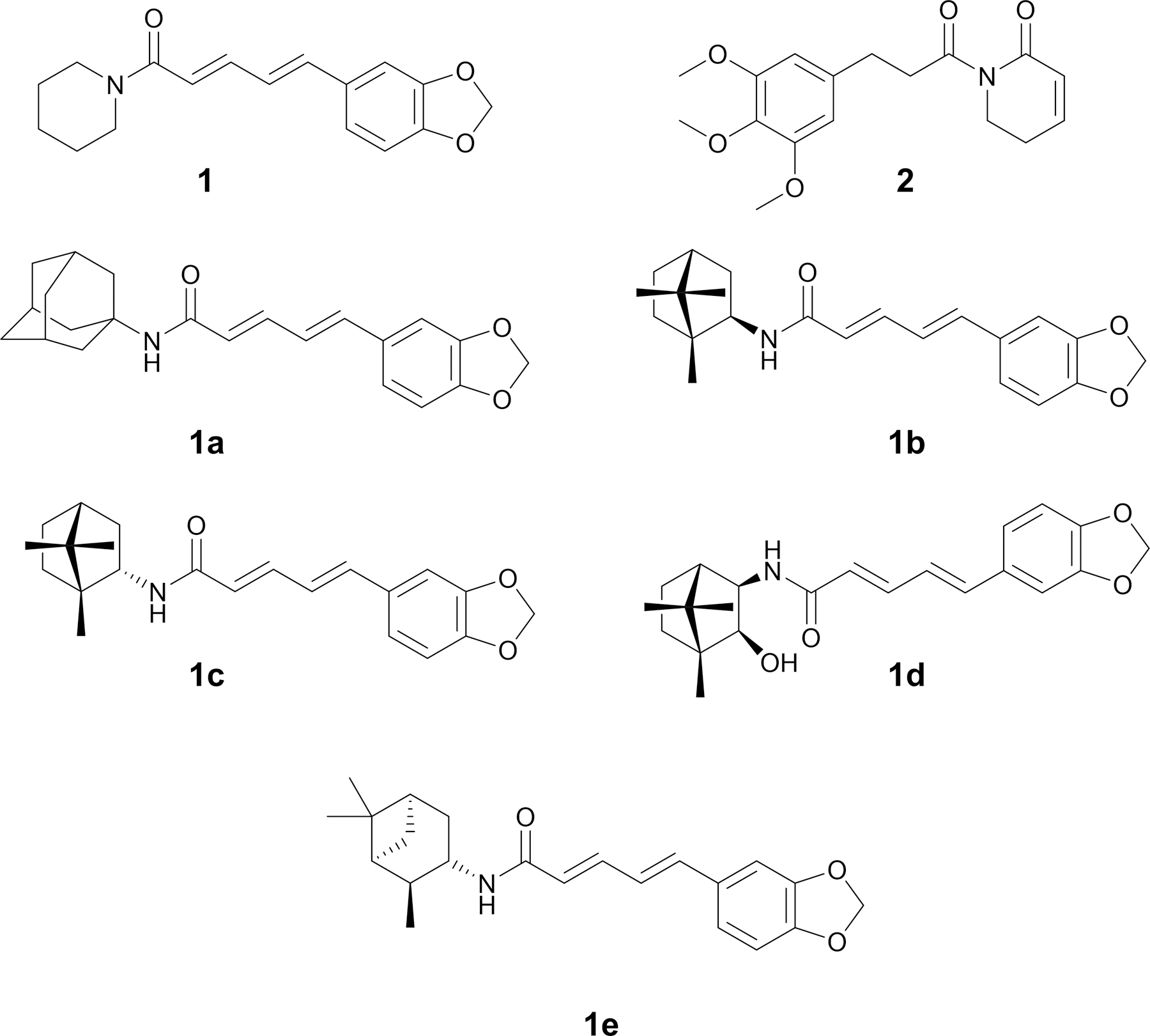
Amide alkaloids and derivatives with antimicrobial activity
Figure 2.
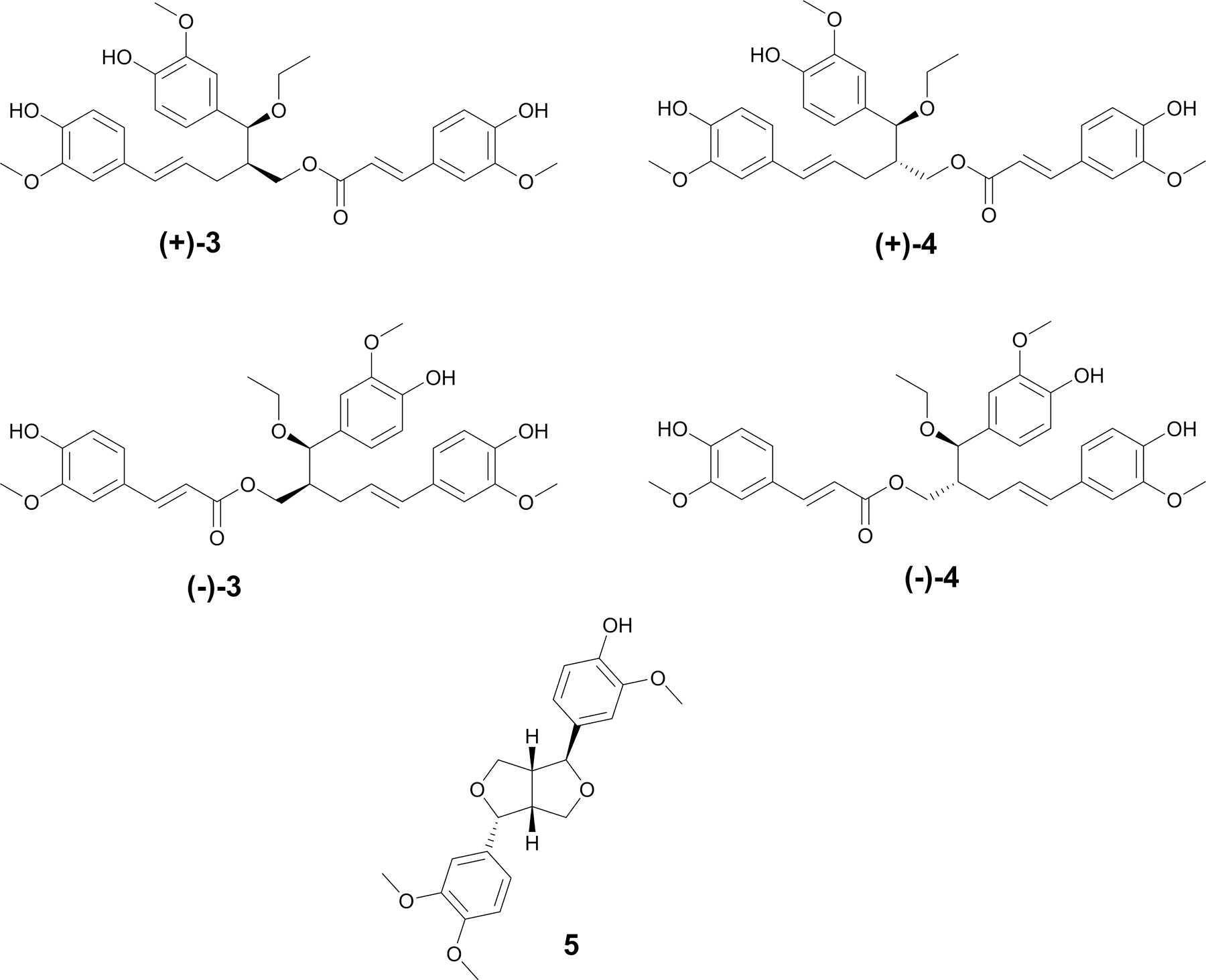
Lignans with antimicrobial activity
Figure 3.
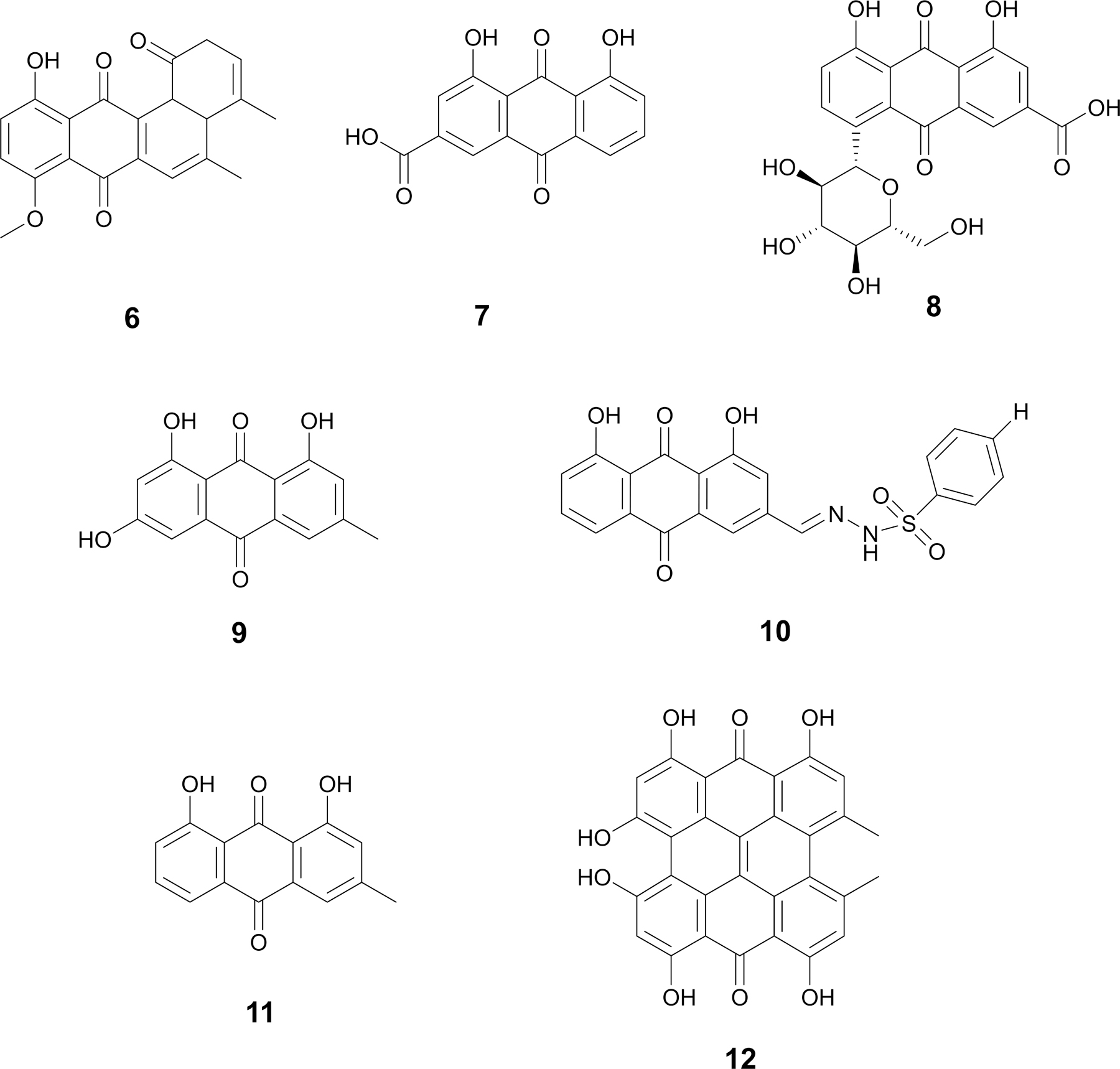
Anthraquinones and derivatives with antimicrobial activity
Figure 4.
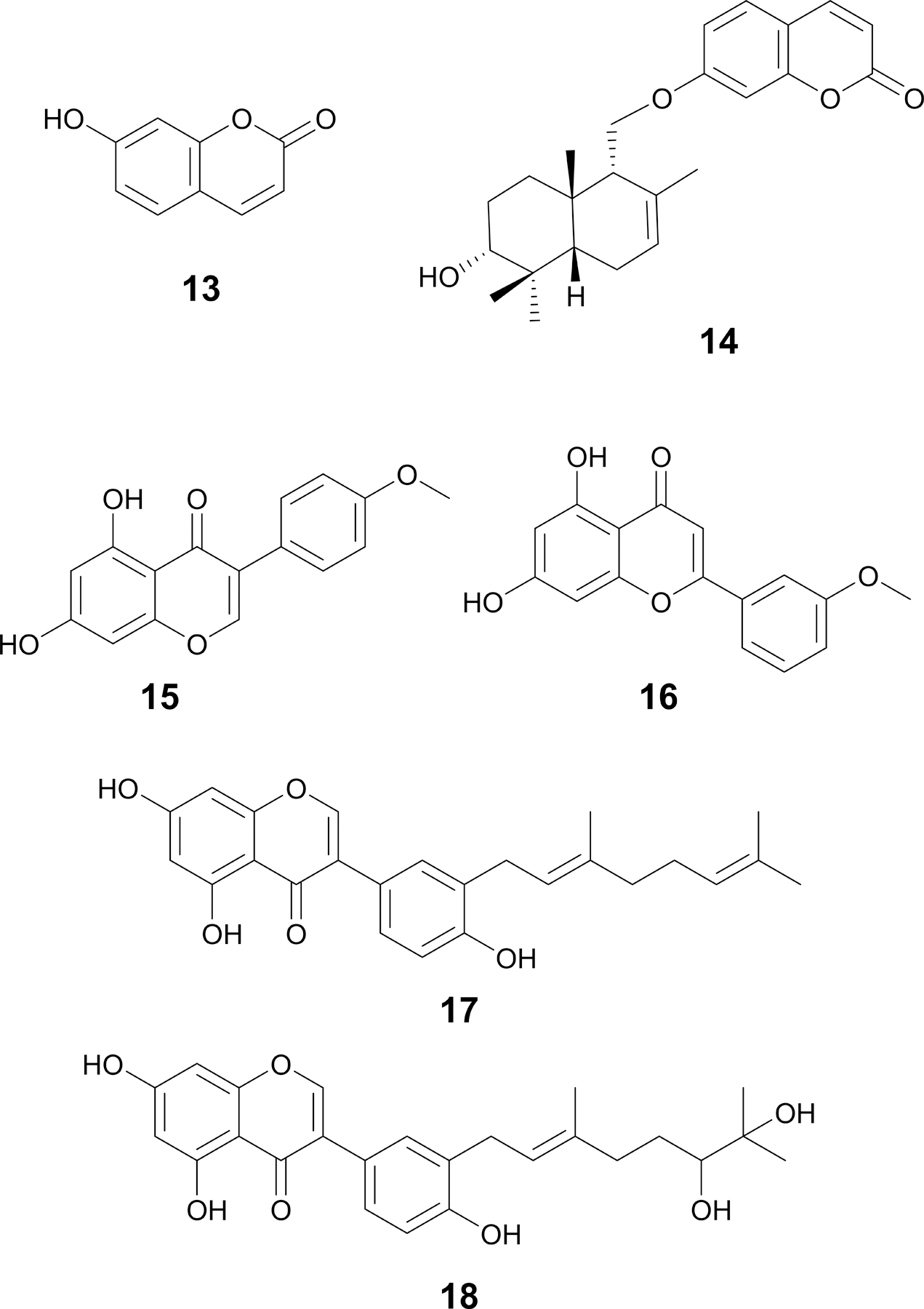
Coumarins, flavonoids and derivatives with antimicrobial activity
Figure 5.
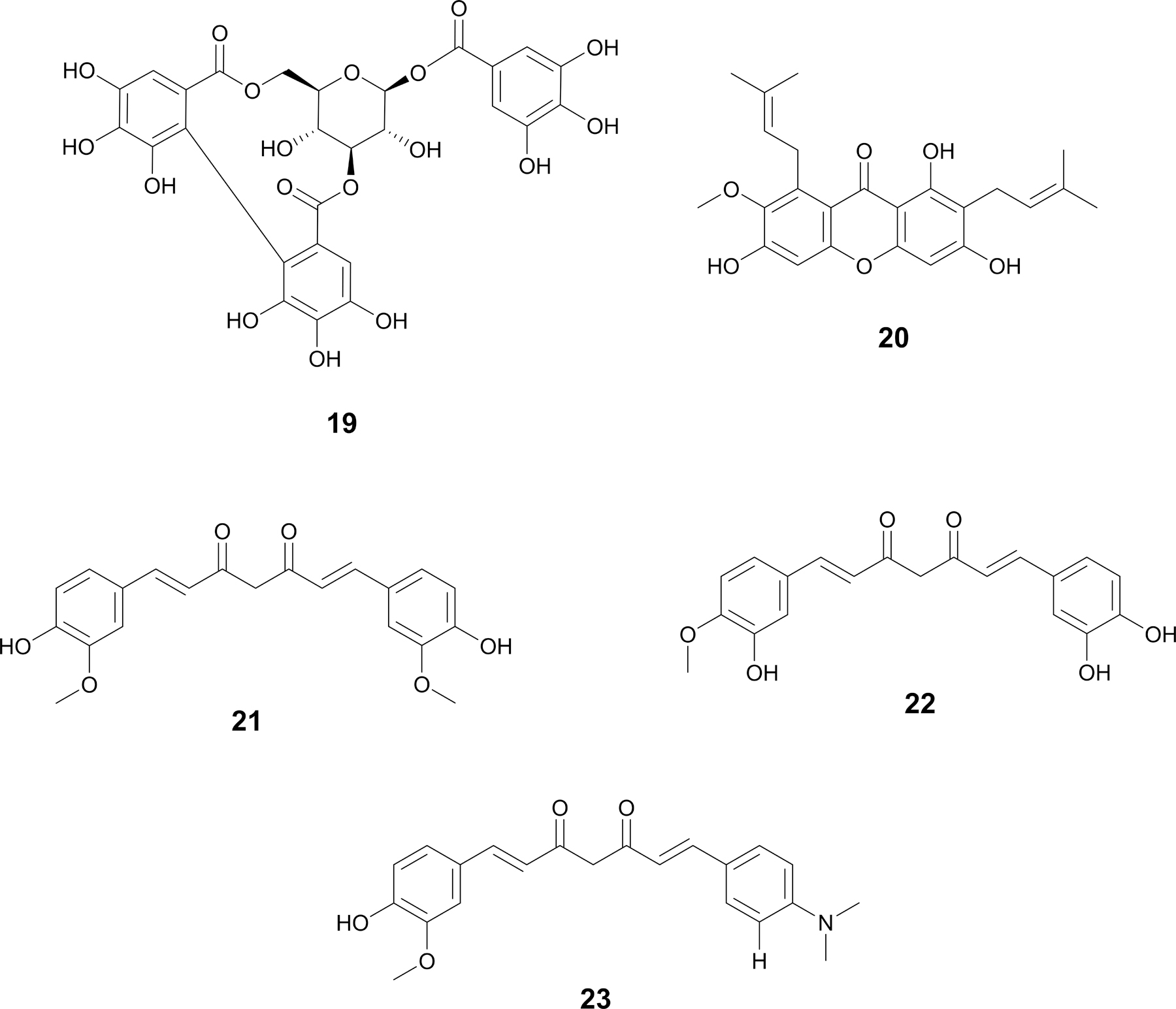
Tannins, xanthones, diarylheptanoids and derivatives with antimicrobial activity
Figure 6.
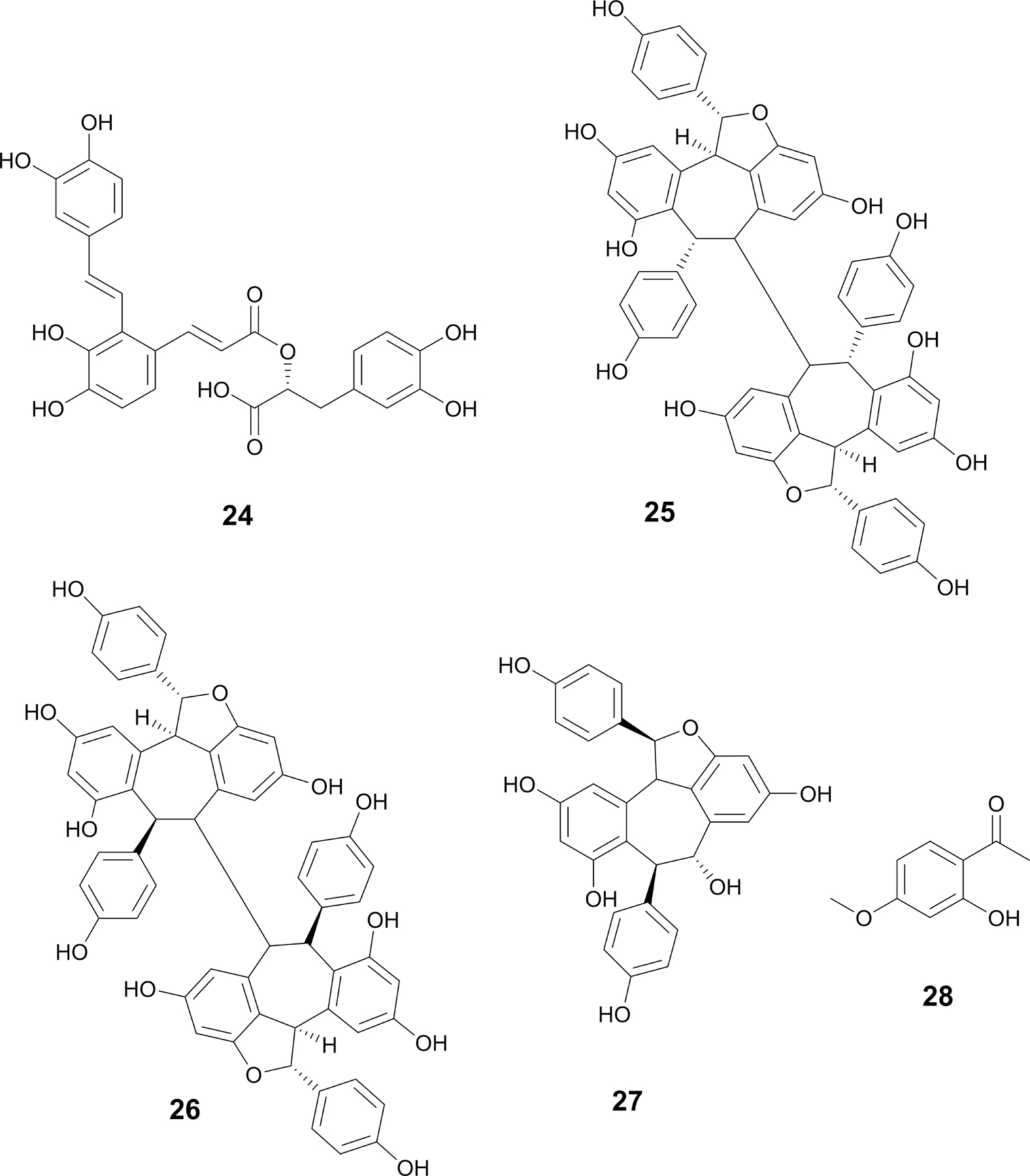
Stilbenes and methoxybenzenes with antimicrobial activity
Figure 7.
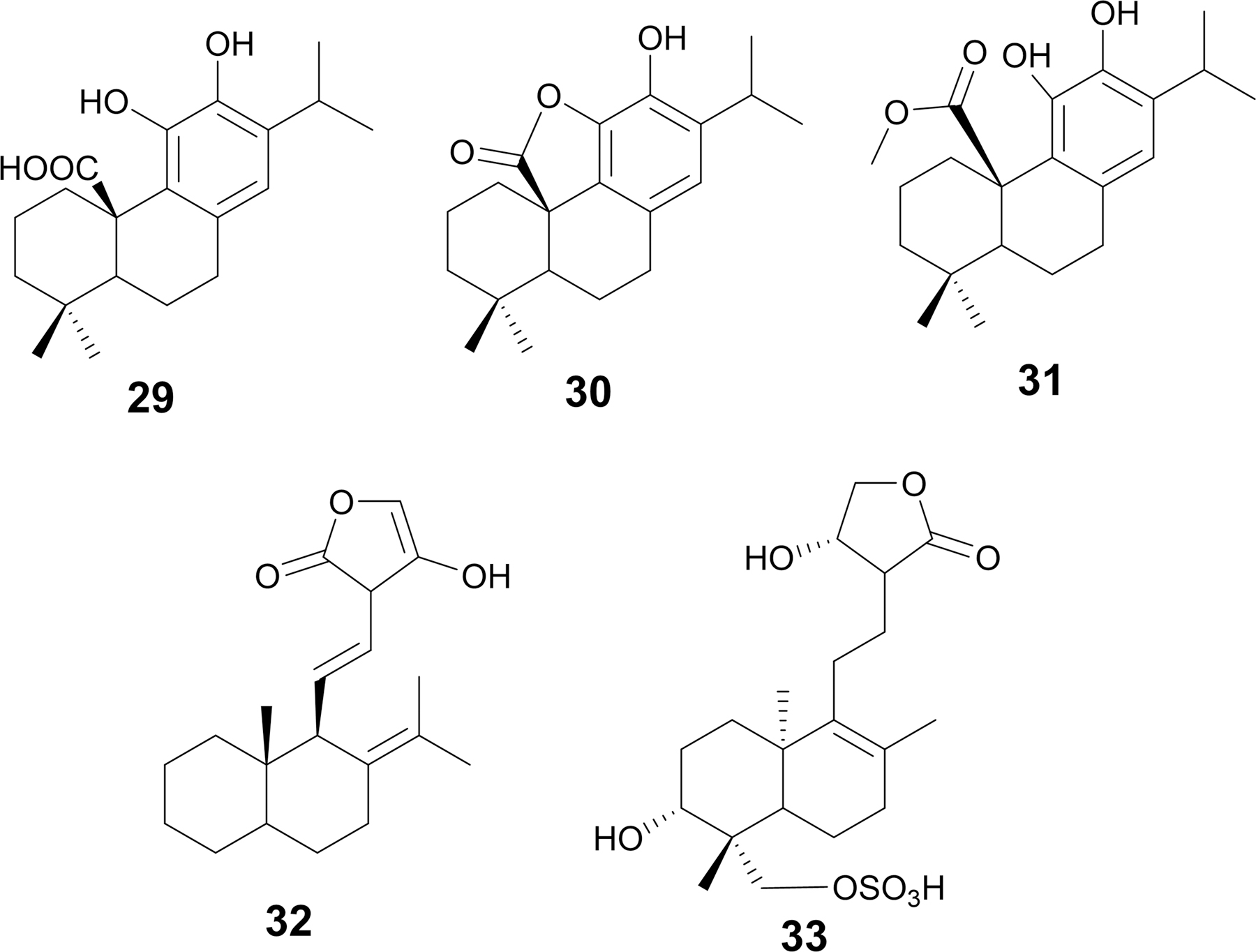
Diterpenes and derivatives with antimicrobial activity
Figure 8.
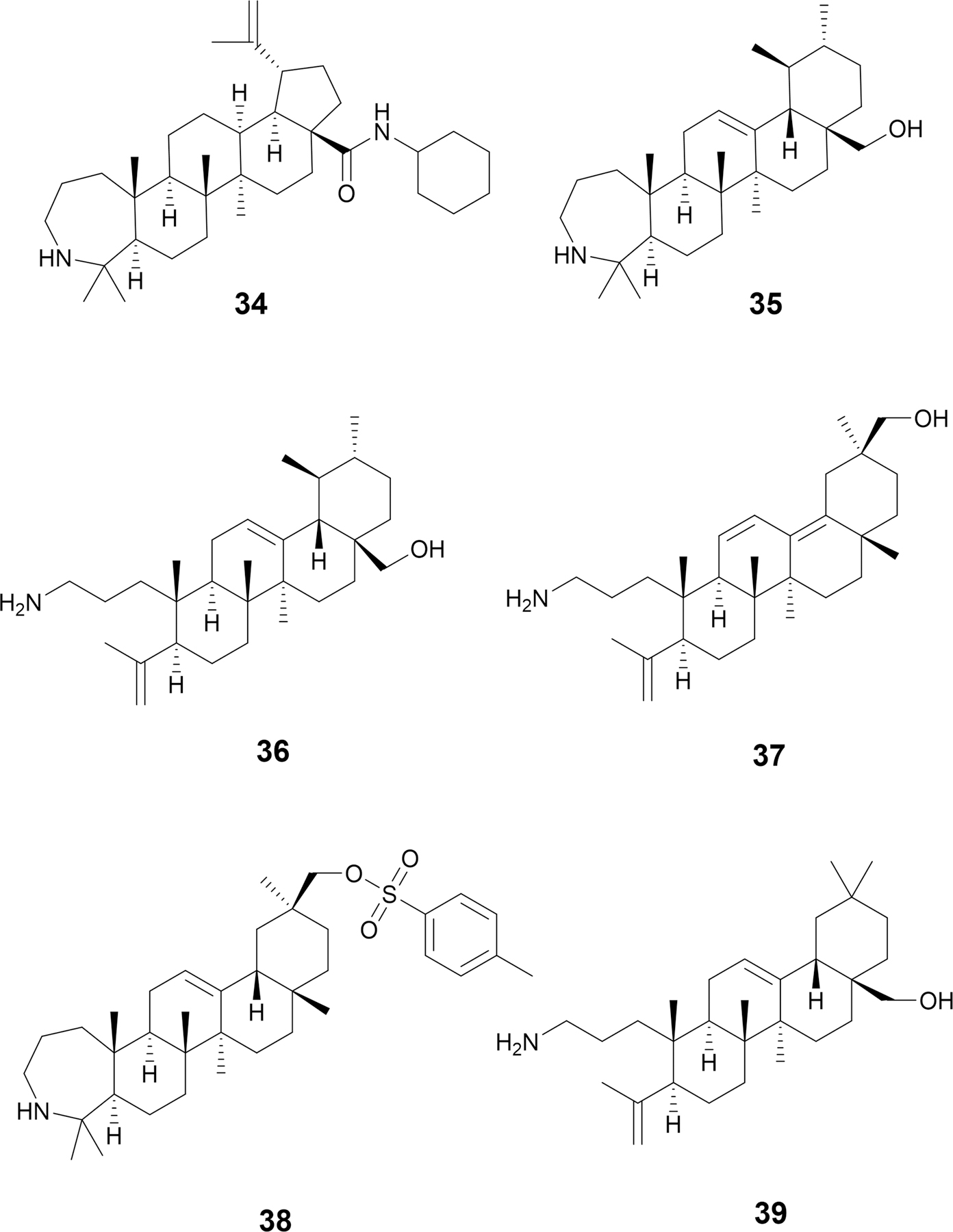
Pentacyclic triterpenes with antibacterial activity
Figure 9.
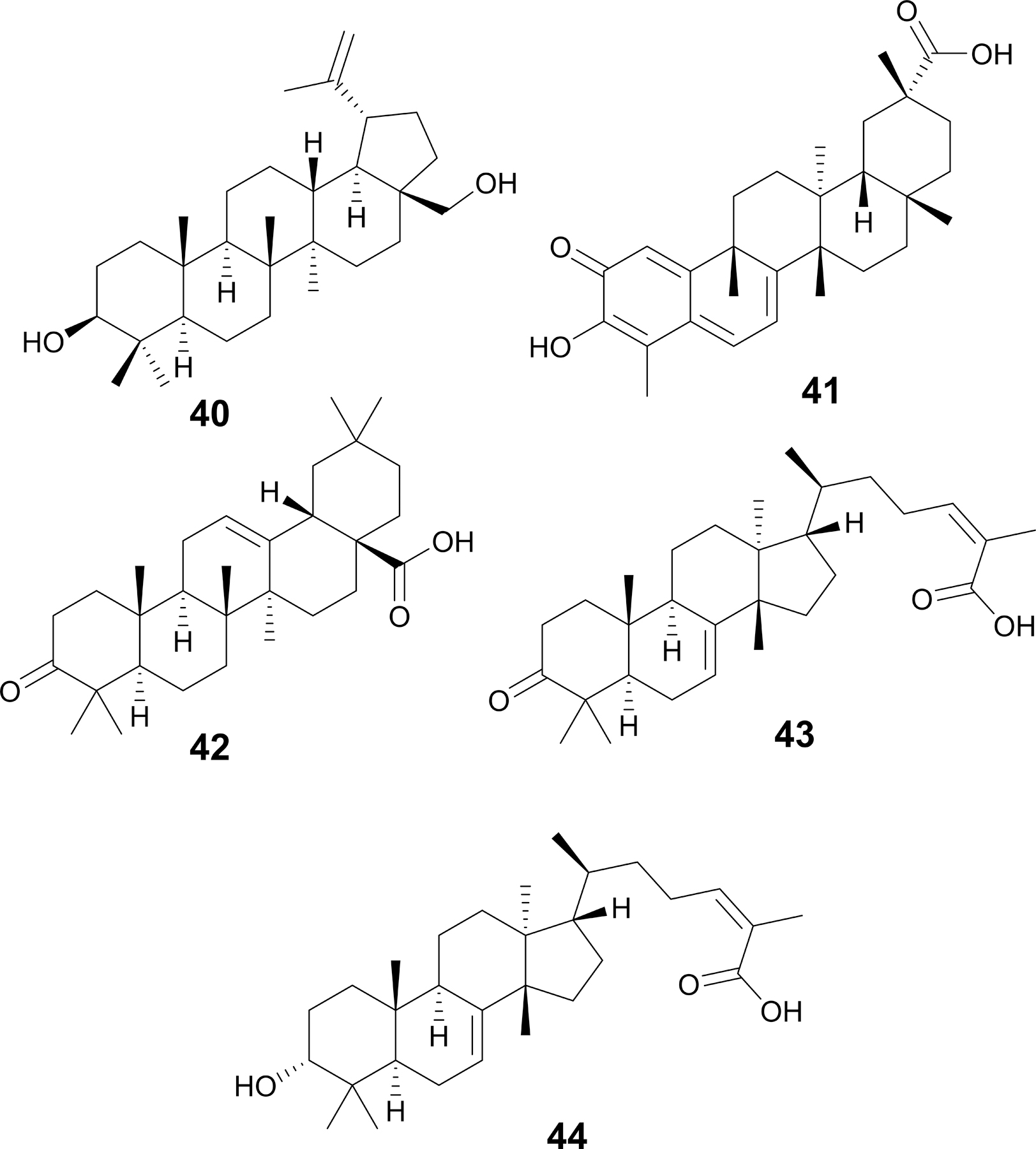
Triterpenoids with antivirulence activity
Figure 10.
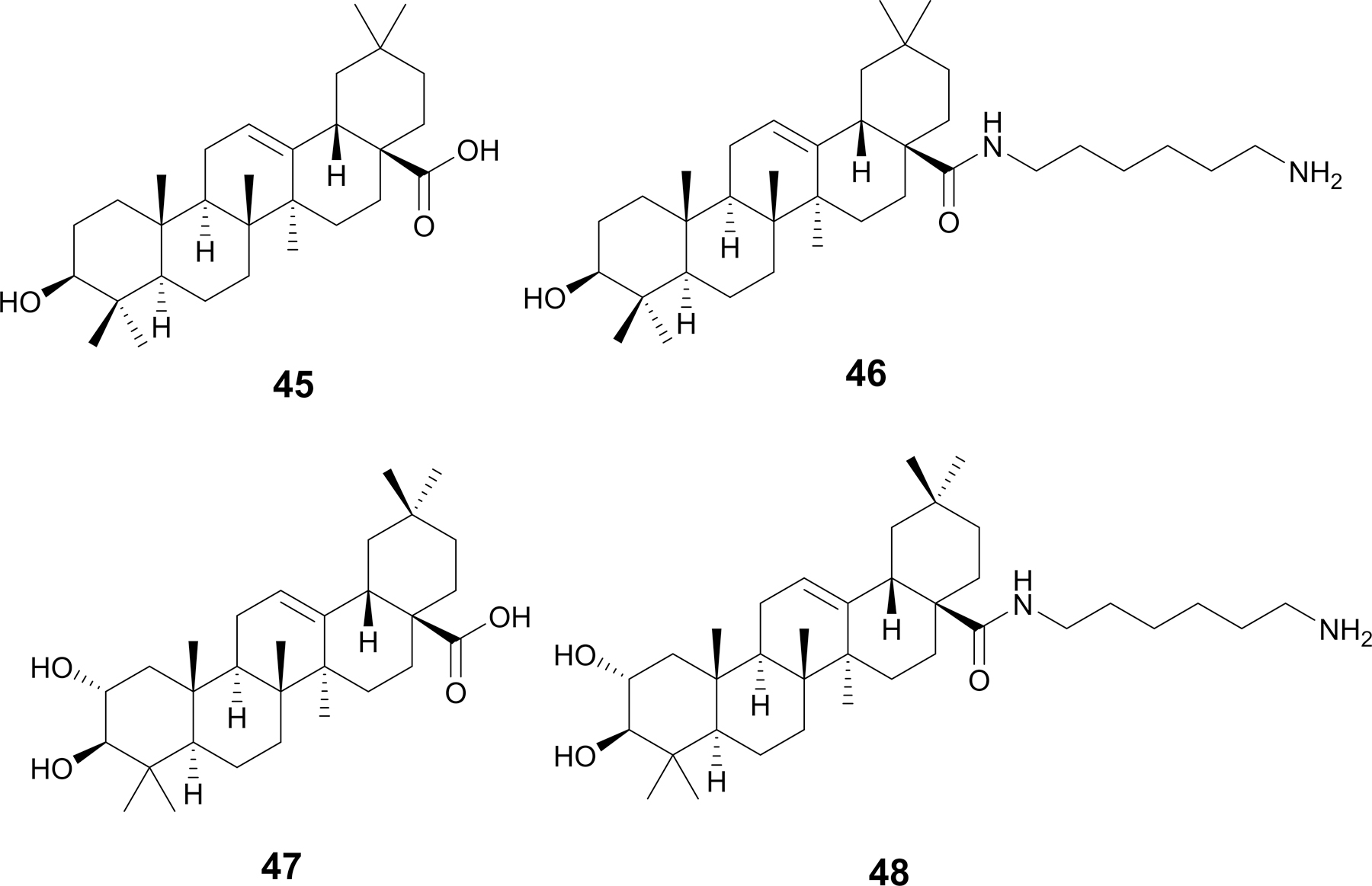
Triterpenoids with antibiofilm activity
9. Acknowledgements
This work was supported by the National Institutes of Health, National Center for Complementary and Integrative Health (R01AT011990 to CLQ; F31AT011988 to CJR; 1F31AT012140-01 to WC) and the Jones Center at Ichauway (to LM). The content is solely the responsibility of the authors and does not necessarily represent the official views of the National Institutes of Health.
Biographies

Dr. Sunmin Woo obtained a Ph.D. from Seoul National University in 2020 under the supervision of Prof. Jinwoong Kim and Sang Hyun Sung studying pharmacognosy. She then conducted postdoctoral research at Seoul National University under Prof. Jinwoong Kim and Prof. Young-Won Chin, and Sookmyung Women’s University under Prof. Kyo Bin Kang. Her research focuses on plant-derived natural products with a focus on SARS-CoV-2 entry inhibition, as well as antibiotic resistance and tolerance in pathogenic bacteria.

Caitlin Risener graduated from Lipscomb University in 2016 with a dual Bachelor and Master’s degree in Biomolecular Science. She is currently a PhD candidate and National Institutes of Health F31 fellow at Emory University in the Molecular and Systems Pharmacology program researching under the mentorship of Dr. Cassandra Quave. Caitlin’s research examines natural products from traditional medicinal plants with antiviral properties against SARS-CoV-2.

William Crandall received his B.S. in Chemistry from The University of North Carolina at Greensboro in 2020 where he worked under the mentorship of Dr. Nadja Cech isolating compounds that inhibit drug-resistant Staphylococcus aureus. He is currently a doctoral student and National Institutes of Health F31 fellow at Emory University in the Molecular and Systems Pharmacology program under the supervision of Dr. Cassandra Quave and Dr. Dean Jones. His primary work and interests include natural product isolation, metabolomics, and polypharmacokinetics of herbal medicines.

Lewis Marquez received his Bachelor of Science in Cell and Molecular Biology from California State University, Northridge in 2018. He is currently a doctoral candidate in the Molecular and Systems Pharmacology program at Emory University where he is funded through a fellowship from The Jones Center at Ichauway, under the mentorship of Dr. Cassandra Quave and Dr. Kier Klepzig. His research focuses on isolating and identifying novel bioactive small molecules from medicinal plants for use against drug-resistant fungi.

Dr. Cassandra Quave is the Thomas J. Lawley, MD Professor of Dermatology, Associate Professor of Dermatology and Human Health at Emory University, where she also serves as the Curator of the Emory Herbarium. Quave is a Fellow of the Explorer’s Club and recipient of the National Academies of Sciences, Engineering, and Medicine Eric and Wendy Schmidt Award for Excellence in Science Communication. Her award-winning science memoir, “The Plant Hunter: A Scientist’s Quest for Nature’s Next Medicines,” was published in 2021. She is the author of over 100 scientific publications and seven patents. Quave’s research interests focus on the documentation of traditional plant uses for food and health and the discovery of novel anti-infective plant-derived natural products.
Footnotes
Conflicts of Interest
CLQ is a founder and CEO/CSO of PhytoTEK LLC, a company developing plant-derived antibiofilm compounds. CLQ is a founder and CSO of Verdant Scientific LLC, a company developing plant-derived antivirulence compounds. CLQ is an Editor for the Natural Product Reports Special Issue “Botanical Natural Products in Drug Discovery, Past, Present and Future.”
10. References
- 1.WHO, Global Action Plan on Antimicrobial Resistance, World Heatlh Organization, 2015. [Google Scholar]
- 2.CDC, Journal, 2019.
- 3.O’Neill J, Tackling Drug-Resistant Infections Globally: Final Report and Recommendations, 2016. [Google Scholar]
- 4.WHO, Antimicrobial resistance surveillance in Europe 2022 – 2020 data, World Heatlh Organization, 2022. [Google Scholar]
- 5.Lancet, 2022, 399, 629–655. [DOI] [PMC free article] [PubMed] [Google Scholar]
- 6.CDC, COVID-19: U.S. Impact on Antimicrobial Resistance, Special Report 2022, Centers for Disease Control and Prevention, 2022. [Google Scholar]
- 7.Rice LB, J. Infect. Dis, 2008, 197, 1079–1081. [DOI] [PubMed] [Google Scholar]
- 8.WHO, Prioritization of pathogens to guide discovery, research and development of new antibiotics for drug-resistant bacterial infections, including tuberculosis, World Health Organization, 2017. [Google Scholar]
- 9.Newman DJ and Cragg GM, J. Nat. Prod, 2020, 83, 770–803. [DOI] [PubMed] [Google Scholar]
- 10.Porras G, Chassagne F, Lyles JT, Marquez L, Dettweiler M, Salam AM, Samarakoon T, Shabih S, Farrokhi DR and Quave CL, Chem. Rev, 2021, 121, 3495–3560. [DOI] [PMC free article] [PubMed] [Google Scholar]
- 11.Wesseling CMJ and Martin NI, ACS Infect. Dis, 2022, 8, 1731–1757. [DOI] [PMC free article] [PubMed] [Google Scholar]
- 12.Singh RP, MedChemComm, 2015, 6, 259–272. [Google Scholar]
- 13.De Oliveira DMP, Forde BM, Kidd TJ, Harris PNA, Schembri MA, Beatson SA, Paterson DL and Walker MJ, Clin. Microbiol. Rev, 2020, 33. [DOI] [PMC free article] [PubMed] [Google Scholar]
- 14.Schultes RE and von Reis S, Ethnobotany: Evolution of a Discipline, Timber Press, 2008. [Google Scholar]
- 15.Melander RJ, Basak AK and Melander C, Natural Product Reports, 2020, 37, 1454–1477. [DOI] [PMC free article] [PubMed] [Google Scholar]
- 16.Levinson W, Chin-Hong P, Joyce EA, Nussbaum J and Schwartz B, in Review of Medical Microbiology & Immunology: A Guide to Clinical Infectious Diseases, 16e, McGraw Hill, New York, NY, 2020. [Google Scholar]
- 17.Balouiri M, Sadiki M and Ibnsouda SK, J Pharm Anal, 2016, 6, 71–79. [DOI] [PMC free article] [PubMed] [Google Scholar]
- 18.Dickey SW, Cheung GYC and Otto M, Nat. Rev. Drug Discov, 2017, 16, 457–471. [DOI] [PMC free article] [PubMed] [Google Scholar]
- 19.Casadevall A and Pirofski LA, Infect. Immun, 1999, 67, 3703–3713. [DOI] [PMC free article] [PubMed] [Google Scholar]
- 20.Donlan RM, Emerg. Infect. Dis, 2002, 8, 881–890. [DOI] [PMC free article] [PubMed] [Google Scholar]
- 21.Muhammad MH, Idris AL, Fan X, Guo Y, Yu Y, Jin X, Qiu J, Guan X and Huang T, Front. Microbiol, 2020, 11, 928. [DOI] [PMC free article] [PubMed] [Google Scholar]
- 22.O’Toole GA, Journal of visualized experiments : JoVE, 2011, DOI: 10.3791/2437. [DOI] [PMC free article] [PubMed] [Google Scholar]
- 23.Azeredo J, Azevedo NF, Briandet R, Cerca N, Coenye T, Costa AR, Desvaux M, Di Bonaventura G, Hébraud M, Jaglic Z, Kačániová M, Knøchel S, Lourenço A, Mergulhão F, Meyer RL, Nychas G, Simões M, Tresse O and Sternberg C, Crit. Rev. Microbiol, 2017, 43, 313–351. [DOI] [PubMed] [Google Scholar]
- 24.Aboelsoud NH, Journal of Medicinal Plants Research, 2010, 4, 082–086. [Google Scholar]
- 25.Heinrich M, Mah J and Amirkia V, Molecules, 2021, 26. [DOI] [PMC free article] [PubMed] [Google Scholar]
- 26.Pennington LD and Moustakas DT, J. Med. Chem, 2017, 60, 3552–3579. [DOI] [PubMed] [Google Scholar]
- 27.Biswas P, Anand U, Saha SC, Kant N, Mishra T, Masih H, Bar A, Pandey DK, Niraj K. Jha, Majumder M, Das N, Vijaykumar S Gadekar, Shekhawat MS, Kumar M, Radha J Proćków, Lastra J. M. P. d. l. and Dey A, J. Cell. Mol. Med, 2022, 26, 3083–3119. [DOI] [PMC free article] [PubMed] [Google Scholar]
- 28.Durant-Archibold AA, Santana AI and Gupta MP, J. Ethnopharmacol, 2018, 217, 63–82. [DOI] [PubMed] [Google Scholar]
- 29.Haq I-U, Imran M, Nadeem M, Tufail T, Gondal TA and Mubarak MS, Phytother. Res, 2021, 35, 680–700. [DOI] [PubMed] [Google Scholar]
- 30.Mgbeahuruike EE, Stålnacke M, Vuorela H and Holm Y, Antibiotics, 2019, 8, 55. [DOI] [PMC free article] [PubMed] [Google Scholar]
- 31.Philipova I, Valcheva V, Mihaylova R, Mateeva M, Doytchinova I and Stavrakov G, Chem. Biol. Drug Des, 2018, 91, 763–768. [DOI] [PubMed] [Google Scholar]
- 32.Pan H, Xu LH, Huang MY, Zha QB, Zhao GX, Hou XF, Shi ZJ, Lin QR, Ouyang DY and He XH, Oncotarget, 2015, 6, 32468–32483. [DOI] [PMC free article] [PubMed] [Google Scholar]
- 33.Desborough MJR and Keeling DM, British Journal of Haematology, 2017, 177, 674–683. [DOI] [PubMed] [Google Scholar]
- 34.Zhang Y, Cai P, Cheng G and Zhang Y, Natural Product Communications, 2022, 17, 1934578X211069721. [Google Scholar]
- 35.Dai J and Mumper RJ, Molecules, 2010, 15, 7313–7352. [DOI] [PMC free article] [PubMed] [Google Scholar]
- 36.Sharma A, Shahzad B, Rehman A, Bhardwaj R, Landi M and Zheng B, Molecules, 2019, 24, 2452. [DOI] [PMC free article] [PubMed] [Google Scholar]
- 37.Wan S-J, Ren H-G, Jiang J-M, Xu G, Xu Y, Chen S-M, Chen G, Zheng D, Yuan M, Zhang H and Xu H-X, Front. Chem, 2022, 10. [DOI] [PMC free article] [PubMed] [Google Scholar]
- 38.Teponno RB, Kusari S and Spiteller M, Nat. Prod. Rep, 2016, 33, 1044–1092. [DOI] [PubMed] [Google Scholar]
- 39.Abbas HA, Atallah H, El-Sayed MA and El-Ganiny AM, Arch. Microbiol, 2020, 202, 2751–2760. [DOI] [PubMed] [Google Scholar]
- 40.Chen Z, Zhang C, Gao F, Fu Q, Fu C, He Y and Zhang J, Food Chem. Toxicol, 2018, 119, 309–325. [DOI] [PubMed] [Google Scholar]
- 41.Zhao Z, Guo P and Brand E, Chin. Med, 2018, 13, 18. [DOI] [PMC free article] [PubMed] [Google Scholar]
- 42.Zhang X, Han B, Feng Z, Jiang J, Yang Y and Zhang P, Acta Pharm. Sin. B, 2018, 8, 818–824. [DOI] [PMC free article] [PubMed] [Google Scholar]
- 43.Liu W, Chu G, Chang N, Ma X, Jiang M and Bai G, RSC Advances, 2017, 7, 40418–40426. [Google Scholar]
- 44.Chen CC, Chen HY, Shiao MS, Lin YL, Kuo YH and Ou JC, Planta Med, 1999, 65, 709–711. [DOI] [PubMed] [Google Scholar]
- 45.Chang M-J, Hung TM, Min B-S, Kim J-C, Woo MH, Choi JS, Lee HK and Bae K, Biosci. Biotechnol. Biochem, 2008, 72, 2750–2755. [DOI] [PubMed] [Google Scholar]
- 46.Lim H, Lee JG, Lee SH, Kim YS and Kim HP, J. Ethnopharmacol, 2008, 118, 113–117. [DOI] [PubMed] [Google Scholar]
- 47.Wang Z, Xia Q, Liu X, Liu W, Huang W, Mei X, Luo J, Shan M, Lin R, Zou D and Ma Z, J. Ethnopharmacol, 2018, 210, 318–339. [DOI] [PubMed] [Google Scholar]
- 48.Malik EM and Müller CE, Med. Res. Rev, 2016, 36, 705–748. [DOI] [PubMed] [Google Scholar]
- 49.Izyani Awang AF, Ahmed QU, Shah SAA, Jaffri JM, Ghafoor K, Uddin ABMH, Ferdosh S and Islam Sarker MZ, Natural Product Research, 2020, 34, 629–637. [DOI] [PubMed] [Google Scholar]
- 50.U.S. Department of Agriculture Agricultural Research Service, Dr. Duke’s Phytochemical and Ethnobotanical Databases, https://phytochem.nal.usda.gov/).
- 51.Fosso MY, Chan KY, Gregory R and Chang C-WT, ACS Combinatorial Science, 2012, 14, 231–235. [DOI] [PubMed] [Google Scholar]
- 52.Folliero V, Dell’Annunziata F, Roscetto E, Amato A, Gasparro R, Zannella C, Casolaro V, De Filippis A, Catania MR, Franci G and Galdiero M, Microbiol. Res, 2022, 261, 127062. [DOI] [PubMed] [Google Scholar]
- 53.Nguyen AT and K.-y. Kim, J. Med. Microbiol, 2020, 69, 689–696. [DOI] [PubMed] [Google Scholar]
- 54.Müller-Heupt LK, Vierengel N, Groß J, Opatz T, Deschner J and von Loewenich FD, Antibiotics (Basel), 2022, 11. [DOI] [PMC free article] [PubMed] [Google Scholar]
- 55.Li Q, Huang Y, Liu X, Gan J, Chen H and Yang CG, J. Biol. Chem, 2016, 291, 11083–11093. [DOI] [PMC free article] [PubMed] [Google Scholar]
- 56.Zhou Y-X, Xia W, Yue W, Peng C, Rahman K and Zhang H, Evid. Based Complement. Alternat. Med, 2015, 2015, 578107. [DOI] [PMC free article] [PubMed] [Google Scholar]
- 57.Zhang Y, Zhu Y, Zuo Y, Tang C, Zhou F, Cui X and Wang L, Curr. Microbiol, 2021, 78, 323–328. [DOI] [PubMed] [Google Scholar]
- 58.Li S, An TY, Li J, Shen Q, Lou FC and Hu LH, J. Asian. Nat. Prod. Res, 2006, 8, 281–286. [DOI] [PubMed] [Google Scholar]
- 59.Zhang LS, Li J and Jia-Ping L, Exp. Ther. Med, 2020, 19, 2871–2878. [DOI] [PMC free article] [PubMed] [Google Scholar]
- 60.Takayama K, Tsutsumi H, Ishizu T and Okamura N, Biol. Pharm. Bull, 2012, 35, 2204–2208. [DOI] [PubMed] [Google Scholar]
- 61.Xiao P, He L and Wang L, J. Ethnopharmacol, 1984, 10, 275–293.6748707 [Google Scholar]
- 62.Đukanović S, Ganić T, Lončarević B, Cvetković S, Nikolić B, Tenji D, Randjelović D and Mitić-Ćulafić D, J. Appl. Microbiol, 2022, 132, 1840–1855. [DOI] [PubMed] [Google Scholar]
- 63.Schilcher K and Horswill AR, Microbiol. Mol. Biol. Rev, 2020, 84. [DOI] [PMC free article] [PubMed] [Google Scholar]
- 64.Sharifi-Rad J, Herrera-Bravo J, Kamiloglu S, Petroni K, Mishra AP, Monserrat-Mesquida M, Sureda A, Martorell M, Aidarbekovna DS, Yessimsiitova Z, Ydyrys A, Hano C, Calina D and Cho WC, Biomed. Pharmacother, 2022, 154, 113555. [DOI] [PubMed] [Google Scholar]
- 65.Earwood C, Folk Life, 1999, 38, 22–31. [Google Scholar]
- 66.Deng Z, Bheemanaboina RRY, Luo Y and Zhou CH, Bioorg Chem, 2022, 127, 106035. [DOI] [PubMed] [Google Scholar]
- 67.Bai J-W, Chen X-R, Tang Y, Cui W-Q, Li D-L, God’spower B-O and Yang Y, RSC Adv, 2019, 9, 28996–29004. [DOI] [PMC free article] [PubMed] [Google Scholar]
- 68.Su S, Wu J, Gao Y, Luo Y, Yang D and Wang P, Biomed. Pharmacother, 2020, 125, 110002. [DOI] [PubMed] [Google Scholar]
- 69.Wang G, Li L, Wang X, Li X, Zhang Y, Yu J, Jiang J, You X and Xiong YQ, Acta Pharm. Sin. B, 2019, 9, 1174–1182. [DOI] [PMC free article] [PubMed] [Google Scholar]
- 70.Choudhary N, Collignon TE, Tewari D and Bishayee A, Phytomedicine, 2022, 105, 154356. [DOI] [PubMed] [Google Scholar]
- 71.Mohamed FF, Anhlan D, Schöfbänker M, Schreiber A, Classen N, Hensel A, Hempel G, Scholz W, Kühn J, Hrincius ER and Ludwig S, Pharmaceuticals (Basel), 2022, 15. [DOI] [PMC free article] [PubMed] [Google Scholar]
- 72.Klemow KM, Bartlow A, Crawford J, Kocher N, Shah J and Ritsick M, in Herbal Medicine: Biomolecular and Clinical Aspects, eds. Benzie IFF and Wachtel-Galor S, CRC Press/Taylor & Francis, Boca Raton (FL), 2011. [PubMed] [Google Scholar]
- 73.Swetha TK, Pooranachithra M, Subramenium GA, Divya V, Balamurugan K and Pandian SK, Front. Cell Infect. Microbiol, 2019, 9, 357. [DOI] [PMC free article] [PubMed] [Google Scholar]
- 74.Amin A, Hanif M, Abbas K, Ramzan M, Rasheed A, Zaman A and Pieters L, Microb. Pathog, 2020, 144, 104184. [DOI] [PubMed] [Google Scholar]
- 75.Mazimba O, Bulletin of Faculty of Pharmacy, Cairo University, 2017, 55, 223–232. [Google Scholar]
- 76.Amiri MS and Joharchi MR, Avicenna J. Phytomed, 2016, 6, 621–635. [PMC free article] [PubMed] [Google Scholar]
- 77.Mahendra P and Bisht S, Pharmacogn. Rev, 2012, 6, 141–146. [DOI] [PMC free article] [PubMed] [Google Scholar]
- 78.Dias MC, Pinto DCGA and Silva AMS, Molecules, 2021, 26, 5377. [DOI] [PMC free article] [PubMed] [Google Scholar]
- 79.Oza MJ and Kulkarni YA, Biomed. Pharmacother, 2018, 107, 1119–1127. [DOI] [PubMed] [Google Scholar]
- 80.Desai V, Jain A, Shaghaghi H, Summer R, Lai JCK and Bhushan A, Anticancer Res, 2019, 39, 57. [DOI] [PubMed] [Google Scholar]
- 81.Chaurasiya ND, Gogineni V, Elokely KM, León F, Núñez MJ, Klein ML, Walker LA, Cutler SJ and Tekwani BL, J. Nat. Prod, 2016, 79, 2538–2544. [DOI] [PubMed] [Google Scholar]
- 82.Pachaiappan R, Rajamuthu TP, Sarkar A, Natrajan P, Krishnan N, Sakthivelu M, Velusamy P, Ramasamy P and Gopinath SCB, Process Biochem, 2022, 116, 84–93. [Google Scholar]
- 83.Shi Z-F, Lei C, Yu B-W, Wang H-Y and Hou A-J, Chem. Biodivers, 2016, 13, 445–450. [DOI] [PubMed] [Google Scholar]
- 84.Shao T-M, Liao H-X, Li X-B, Chen G-Y, Song X-P and Han C-R, Natural Product Research, 2022, 36, 1191–1196. [DOI] [PubMed] [Google Scholar]
- 85.Tamta G, Mehra N and Tandon S, Journal of Drug Delivery and Therapeutics, 2021, 11, 163–169. [Google Scholar]
- 86.Yuan G, Guan Y, Yi H, Lai S, Sun Y and Cao S, Sci. Rep, 2021, 11, 10471. [DOI] [PMC free article] [PubMed] [Google Scholar]
- 87.Babii C, Bahrin LG, Neagu A-N, Gostin I, Mihasan M, Birsa LM and Stefan M, J. Appl. Microbiol, 2016, 120, 630–637. [DOI] [PubMed] [Google Scholar]
- 88.Echeverría J, Opazo J, Mendoza L, Urzúa A and Wilkens M, Molecules, 2017, 22, 608. [DOI] [PMC free article] [PubMed] [Google Scholar]
- 89.Schmidt OT and Lademann R, Justus Liebigs Ann. Chem, 1951, 571, 232–237. [Google Scholar]
- 90.Olmedo-Juárez A, Briones-Robles TI, Zaragoza-Bastida A, Zamilpa A, Ojeda-Ramírez D, Mendoza de Gives P, Olivares-Pérez J and Rivero-Perez N, Microb. Pathog, 2019, 136, 103660. [DOI] [PubMed] [Google Scholar]
- 91.Li X, Deng Y, Zheng Z, Huang W, Chen L, Tong Q and Ming Y, Biomed. Pharmacother, 2018, 99, 43–50. [DOI] [PubMed] [Google Scholar]
- 92.Sarin B, Verma N, Martín JP and Mohanty A, ScientificWorldJournal, 2014, 2014, 839172. [DOI] [PMC free article] [PubMed] [Google Scholar]
- 93.Feng Z, Lu X, Gan L, Zhang Q and Lin L, Molecules, 2020, 25, 598. [DOI] [PMC free article] [PubMed] [Google Scholar]
- 94.Felix L, Mishra B, Khader R, Ganesan N and Mylonakis E, Front. Cell Infect. Microbiol, 2022, 12, 898794. [DOI] [PMC free article] [PubMed] [Google Scholar]
- 95.Singh VK, Syring M, Singh A, Singhal K, Dalecki A and Johansson T, Int. J. Med. Microbiol, 2012, 302, 242–252. [DOI] [PubMed] [Google Scholar]
- 96.Gutierrez-Orozco F, Chitchumroonchokchai C, Lesinski GB, Suksamrarn S and Failla ML, J. Agric. Food Chem, 2013, 61, 3891–3900. [DOI] [PMC free article] [PubMed] [Google Scholar]
- 97.Parekh P, Sharma N, Sharma M, Gadepalli A, Sayyed AA, Chatterjee S, Kate A and Khairnar A, Metab. Brain Dis, 2022, DOI: 10.1007/s11011-022-01087-1. [DOI] [PubMed] [Google Scholar]
- 98.Tarasuk M, Songprakhon P, Chieochansin T, Choomee K, Na-Bangchang K and Yenchitsomanus PT, Sci. Rep, 2022, 12, 16088. [DOI] [PMC free article] [PubMed] [Google Scholar]
- 99.Pedraza-Chaverri J, Cárdenas-Rodríguez N, Orozco-Ibarra M and Pérez-Rojas JM, Food Chem. Toxicol, 2008, 46, 3227–3239. [DOI] [PubMed] [Google Scholar]
- 100.Sharifi-Rad J, Rayess YE, Rizk AA, Sadaka C, Zgheib R, Zam W, Sestito S, Rapposelli S, Neffe-Skocińska K, Zielińska D, Salehi B, Setzer WN, Dosoky NS, Taheri Y, El Beyrouthy M, Martorell M, Ostrander EA, Suleria HAR, Cho WC, Maroyi A and Martins N, Front. Pharmacol, 2020, 11, 01021. [DOI] [PMC free article] [PubMed] [Google Scholar]
- 101.Noureddin SA, El-Shishtawy RM and Al-Footy KO, Eur. J. Med. Chem, 2019, 182, 111631. [DOI] [PubMed] [Google Scholar]
- 102.Yang L, Connaris H, Potter JA and Taylor GL, BMC Struct. Biol, 2015, 15, 15. [DOI] [PMC free article] [PubMed] [Google Scholar]
- 103.Vogel A and Pelletier J, J. Pharm, 1815, 1, 289–300. [Google Scholar]
- 104.A. B. Prasad S, in Turmeric, the Golden Spice: From Traditional Medicine to Modern Medicine, ed. W.-G. S. Benzie IFF, CRC Press/Taylor & Francis, Boca Raton (FL), 2nd edn., 2011, ch. Chapter 13. [PubMed] [Google Scholar]
- 105.Araújo CC and Leon LL, Mem. Inst. Oswaldo Cruz, 2001, 96, 723–728. [DOI] [PubMed] [Google Scholar]
- 106.Lian-Niang L, Rui T and Wei-Ming C, Planta Med, 1984, 50, 227–228. [DOI] [PubMed] [Google Scholar]
- 107.Mu D, Luan Y, Wang L, Gao Z, Yang P, Jing S, Wang Y, Xiang H, Wang T and Wang D, Emerg. Microbes Infect, 2020, 9, 169–179. [DOI] [PMC free article] [PubMed] [Google Scholar]
- 108.Wang L, Ma R, Liu C, Liu H, Zhu R, Guo S, Tang M, Li Y, Niu J, Fu M, Gao S and Zhang D, Curr. Pharm. Des, 2017, 23, 1077–1097. [DOI] [PMC free article] [PubMed] [Google Scholar]
- 109.Su C-Y, Ming Q-L, Rahman K, Han T and Qin L-P, Chin. J. Nat. Med, 2015, 13, 163–182. [DOI] [PubMed] [Google Scholar]
- 110.Keylor MH, Matsuura BS and Stephenson CRJ, Chem. Rev, 2015, 115, 8976–9027. [DOI] [PMC free article] [PubMed] [Google Scholar]
- 111.Shen J, Zhou Q, Li P, Wang Z, Liu S, He C, Zhang C and Xiao P, Molecules, 2017, 22. [DOI] [PMC free article] [PubMed] [Google Scholar]
- 112.Kang JE, Yoo N, Jeon BJ, Kim BS and Chung E-H, Front. Plant Sci, 2022, 13. [DOI] [PMC free article] [PubMed] [Google Scholar]
- 113.Kawabata J, Fukushi E, Hara M and Mizutani J, Magn. Reson. Chem, 1992, 30, 6–10. [Google Scholar]
- 114.Coggon P, King T and Wallwork S, Chem. Commun. (London), 1966, 439–440. [Google Scholar]
- 115.Zetterström CE, Hasselgren J, Salin O, Davis RA, Quinn RJ, Sundin C and Elofsson M, PLoS One, 2013, 8, e81969. [DOI] [PMC free article] [PubMed] [Google Scholar]
- 116.Kang JE, Jeon BJ, Park MY, Yang HJ, Kwon J, Lee DH and Kim BS, Pest Manag. Sci, 2020, 76, 2294–2303. [DOI] [PubMed] [Google Scholar]
- 117.Burns J, Yokota T, Ashihara H, Lean MEJ and Crozier A, J. Agric. Food Chem, 2002, 50, 3337–3340. [DOI] [PubMed] [Google Scholar]
- 118.Ma BN and Li XJ, Chin. Herb. Med, 2020, 12, 349–358. [DOI] [PMC free article] [PubMed] [Google Scholar]
- 119.Yang H, Zhang R, Jia C, Chen M, Yin W, Wei L and Jiao H, Pharm. Biol, 2019, 57, 22–28. [DOI] [PMC free article] [PubMed] [Google Scholar]
- 120.Chuang W-C, Lin W-C, Sheu S-J, Chiou S-H, Chang H-C and Chen Y-P, Planta Med, 1996, 62, 347–351. [DOI] [PubMed] [Google Scholar]
- 121.Ducki S, Hadfield JA, Lawrence NJ, Zhang X and McGown AT, Planta Med, 1995, 61, 586–587. [DOI] [PubMed] [Google Scholar]
- 122.Lv Q, Li S, Wei H, Wen Z, Wang Y, Tang T, Wang J, Xia L and Deng X, Appl. Microbiol. Biotechnol, 2020, 104, 1673–1682. [DOI] [PubMed] [Google Scholar]
- 123.Zhao M and Wu SP, S. Afr. J. Bot, 2019, 124, 556–563. [Google Scholar]
- 124.A. C. R. g. Qinghaosu, Chinese Medical Journal, 1979, 92, 811–816. [PubMed] [Google Scholar]
- 125.Chabán MF, Karagianni C, Joray MB, Toumpa D, Sola C, Crespo MI, Palacios SM, Athanassopoulos CM and Carpinella MC, J. Ethnopharmacol, 2019, 239, 111930. [DOI] [PubMed] [Google Scholar]
- 126.Park M-Y and Sung M-K, J. Sci. Food Agric, 2015, 95, 828–835. [DOI] [PubMed] [Google Scholar]
- 127.González MA, Nat. Prod. Rep, 2015, 32, 684–704. [DOI] [PubMed] [Google Scholar]
- 128.Manner S, Vahermo M, Skogman ME, Krogerus S, Vuorela PM, Yli-Kauhaluoma J, Fallarero A and Moreira VM, Eur. J. Med. Chem, 2015, 102, 68–79. [DOI] [PubMed] [Google Scholar]
- 129.Aranda FJ and Villalaín J, Biochimica et Biophysica Acta (BBA) - Biomembranes, 1997, 1327, 171–180. [DOI] [PubMed] [Google Scholar]
- 130.Bussmann RW and Sharon D, Journal of Ethnobiology and Ethnomedicine, 2006, 2, 47. [DOI] [PMC free article] [PubMed] [Google Scholar]
- 131.Bassey K, Mamabolo P and Cosa S, Biology (Basel), 2021, 10. [DOI] [PMC free article] [PubMed] [Google Scholar]
- 132.Maroyi A, J. Appl. Pharm. Sci, 2019. [Google Scholar]
- 133.Zhang L, Wen B, Bao M, Cheng Y, Mahmood T, Yang W, Chen Q, Lv L, Li L, Yi J, Xie N, Lu C and Tan Y, Front. Pharmacol, 2021, 12, 720685. [DOI] [PMC free article] [PubMed] [Google Scholar]
- 134.Zhao Y, Huang P, Chen Z, Zheng SW, Yu JY and Shi C, J. Huazhong Univ. Sci. Technolog. Med. Sci, 2017, 37, 293–299. [DOI] [PubMed] [Google Scholar]
- 135.Zeng B, Wei A, Zhou Q, Yuan M, Lei K, Liu Y, Song J, Guo L and Ye Q, Phytother. Res, 2022, 36, 336–364. [DOI] [PubMed] [Google Scholar]
- 136.Sheng H and Sun H, Nat. Prod. Rep, 2011, 28, 543–593. [DOI] [PubMed] [Google Scholar]
- 137.Hill RA and Connolly JD, Nat. Prod. Rep, 2020, 37, 962–998. [DOI] [PubMed] [Google Scholar]
- 138.Xu R, Fazio GC and Matsuda SPT, Phytochemistry, 2004, 65, 261–291. [DOI] [PubMed] [Google Scholar]
- 139.Kazakova O, Tret’yakova E and Baev D, The Journal of Antibiotics, 2021, 74, 559–573. [DOI] [PMC free article] [PubMed] [Google Scholar]
- 140.de León L, López MR and Moujir L, Microbiol. Res, 2010, 165, 617–626. [DOI] [PubMed] [Google Scholar]
- 141.Kazakova O, Rubanik L, Smirnova I, Poleschuk N, Petrova A, Kapustsina Y, Baikova I, Tret’yakova E and Khusnutdinova E, Medicinal Chemistry Research, 2021, 30, 1408–1418. [Google Scholar]
- 142.Pollier J and Goossens A, Phytochemistry, 2012, 77, 10–15. [DOI] [PubMed] [Google Scholar]
- 143.Huang L, Luo H, Li Q, Wang D, Zhang J, Hao X and Yang X, Eur. J. Med. Chem, 2015, 95, 64–75. [DOI] [PubMed] [Google Scholar]
- 144.Šiman P, Filipová A, Tichá A, Niang M, Bezrouk A and Havelek R, PLoS One, 2016, 11, e0154933. [DOI] [PMC free article] [PubMed] [Google Scholar]
- 145.Rastogi S, Pandey MM and Kumar Singh Rawat A, J. Ethnopharmacol, 2015, 159, 62–83. [DOI] [PMC free article] [PubMed] [Google Scholar]
- 146.Moerman DE, Native American ethnobotany, Timber Press, Portland, OR, 1998. [Google Scholar]
- 147.Lu G, Xu L, Zhang P, Dou X, Yu J and Feng H, Fitoterapia, 2019, 139, 104409. [DOI] [PubMed] [Google Scholar]
- 148.Sethi G, Ahn KS, Pandey MK and Aggarwal BB, Blood, 2007, 109, 2727–2735. [DOI] [PubMed] [Google Scholar]
- 149.Wang L, Wang Z, Yang Z, Yang K and Yang H, Front. Mol. Biosci, 2021, 8, 664416. [DOI] [PMC free article] [PubMed] [Google Scholar]
- 150.Bao J and Dai S-M, Rheumatol. Int, 2011, 31, 1123–1129. [DOI] [PubMed] [Google Scholar]
- 151.Kannaiyan R, Shanmugam MK and Sethi G, Cancer Lett, 2011, 303, 9–20. [DOI] [PubMed] [Google Scholar]
- 152.Yehia F. A.-z. A., Yousef N and Askoura M, BMC Microbiol, 2022, 22, 106. [DOI] [PMC free article] [PubMed] [Google Scholar]
- 153.Tang H, Porras G, Brown MM, Chassagne F, Lyles JT, Bacsa J, Horswill AR and Quave CL, Sci. Rep, 2020, 10, 8046. [DOI] [PMC free article] [PubMed] [Google Scholar]
- 154.Cheung GYC, Wang R, Khan BA, Sturdevant DE and Otto M, Infect. Immun, 2011, 79, 1927–1935. [DOI] [PMC free article] [PubMed] [Google Scholar]
- 155.Morton JF, Economic Botany, 1978, 32, 353–359. [Google Scholar]
- 156.Fedel-Miyasato LE, Formagio AS, Auharek SA, Kassuya CA, Navarro SD, Cunha-Laura AL, Monreal AC, Vieira MC and Oliveira RJ, Genet. Mol. Res, 2014, 13, 3411–3425. [DOI] [PubMed] [Google Scholar]
- 157.Blanco-Cabra N, Vega-Granados K, Moya-Andérico L, Vukomanovic M, Parra A, Álvarez de Cienfuegos L and Torrents E, ACS Infect. Dis, 2019, 5, 1581–1589. [DOI] [PubMed] [Google Scholar]
- 158.Ayeleso TB, Matumba MG and Mukwevho E, Molecules, 2017, 22. [DOI] [PMC free article] [PubMed] [Google Scholar]
- 159.Lozano-Mena G, Sánchez-González M, Juan ME and Planas JM, Molecules, 2014, 19, 11538–11559. [DOI] [PMC free article] [PubMed] [Google Scholar]
- 160.Hashmi MA, Khan A, Hanif M, Farooq U and Perveen S, Evid. Based Complement. Alternat. Med, 2015, 2015, 541591. [DOI] [PMC free article] [PubMed] [Google Scholar]
- 161.Kim BR, Park J-Y, Jeong HJ, Kwon H-J, Park S-J, Lee I-C, Ryu YB and Lee WS, Journal of Enzyme Inhibition and Medicinal Chemistry, 2018, 33, 1256–1265. [DOI] [PMC free article] [PubMed] [Google Scholar]
- 162.Wan S-J, Ren H-G, Jiang J-M, Xu G, Xu Y, Chen S-M, Chen G, Zheng D, Yuan M, Zhang H and Xu H-X, Frontiers in Chemistry, 2022, 10. [DOI] [PMC free article] [PubMed] [Google Scholar]
- 163.Lv Q, Li S, Wei H, Wen Z, Wang Y, Tang T, Wang J, Xia L and Deng X, Applied Microbiology and Biotechnology, 2020, 104, 1673–1682. [DOI] [PubMed] [Google Scholar]
- 164.Mu D, Luan Y, Wang L, Gao Z, Yang P, Jing S, Wang Y, Xiang H, Wang T and Wang D, Emerging Microbes & Infections, 2020, 9, 169–179. [DOI] [PMC free article] [PubMed] [Google Scholar]
- 165.Kang JE, Jeon BJ, Park MY, Yang HJ, Kwon J, Lee DH and Kim BS, Pest Manag Sci, 2020, 76, 2294–2303. [DOI] [PubMed] [Google Scholar]
- 166.Li K, Han X, Li R, Xu Z, Pan T, Liu J, Li B, Wang S, Diao Y and Liu X, Journal of Food Science, 2019, 84, 1721–1729. [DOI] [PubMed] [Google Scholar]
- 167.F. A.-z. A. Yehia, N. Yousef and M. Askoura, BMC Microbiology, 2022, 22, 106. [DOI] [PMC free article] [PubMed] [Google Scholar]
- 168.Tang H, Porras G, Brown MM, Chassagne F, Lyles JT, Bacsa J, Horswill AR and Quave CL, Scientific Reports, 2020, 10, 8046. [DOI] [PMC free article] [PubMed] [Google Scholar]
- 169.Wong C, New Sci, 2023, 257, 14. [DOI] [PMC free article] [PubMed] [Google Scholar]
- 170.The effect of orally ingested Curcumin and Piperine on the rate of orthodontic tooth movement and the extent of root resorption in a rodent model – A pilot study, https://preclinicaltrials.eu/database/view-protocol/197, (accessed 04-24, 2023).
- 171.Celastrol attenuates the remodeling of pulmonary vascular and right ventricular in monocrotaline-induced pulmonary arterial hypertension in rat, 10.17590/asr.0000266, (accessed 04-24, 2023). [DOI] [PMC free article] [PubMed]


